51 Stunning Succulents With Orange Flowers (With Pictures)
Are you searching for succulents with pretty orange flowers? Well, your search ends here! In this awesome list, you’ll find 51 different varieties, complete with vibrant pictures and detailed descriptions. It doesn’t matter if you’re a succulent pro or just someone wanting to add a splash of color to their home, these incredible plants will definitely blow you away. So, why wait any longer? Dive in and prepare to be dazzled!

Related Post:
1,000 Types of Succulents (With Pictures)
Contents
- 1 51 Succulents With Orange Flowers
- 1.1 Aloe arborescens
- 1.2 Aloe ferox
- 1.3 Aloe marlothii
- 1.4 Cleistocactus icosagonus
- 1.5 Conophytum frutescens
- 1.6 Conophytum loeschianum
- 1.7 Cotyledon eliseae
- 1.8 Cotyledon orbiculata
- 1.9 Cotyledon pendens
- 1.10 Cotyledon tomentosa
- 1.11 Cotyledon undulata
- 1.12 Crassula capitella ‘Campfire’
- 1.13 Crassula columnaris
- 1.14 Crassula perfoliata var. falcata
- 1.15 Dudleya brittonii
- 1.16 Dudleya saxosa
- 1.17 Echeveria ‘Doris Taylor’
- 1.18 Echeveria atropurpurea
- 1.19 Echeveria bifida
- 1.20 Echeveria cante
- 1.21 Echeveria cv. Bombicina
- 1.22 Echeveria diffractens
- 1.23 Echeveria laui
- 1.24 Echeveria lilacina
- 1.25 Echeveria lutea
- 1.26 Echeveria pulv-oliver
- 1.27 Echeveria purpusorum
- 1.28 Echeveria runyonii cv. Topsy Turvy
- 1.29 Echinopsis chamaecereus
- 1.30 Fenestraria rhopalophylla subs. aurantiaca cv. Fireworth
- 1.31 Ferocactus cylindraceus
- 1.32 Graptoveria cv. Fred Ives
- 1.33 Hereroa puttkameriana
- 1.34 Kalanchoe beharensis
- 1.35 Kalanchoe blossfeldiana ‘Orange’
- 1.36 Kalanchoe bracteata
- 1.37 Kalanchoe crenata
- 1.38 Kalanchoe fedtschenkoi
- 1.39 Kalanchoe manginii
- 1.40 Kalanchoe rotundifolia
- 1.41 Kalanchoe х houghtonii
- 1.42 Lampranthus aurantiacus
- 1.43 Lobivia jajoiana
- 1.44 Opuntia rufida
- 1.45 Pachyphytum oviferum
- 1.46 Rebutia fiebrigii
- 1.47 Rebutia muscula
- 1.48 Sedum kimnachii
- 1.49 Sedum palmeri
- 1.50 Tylecodon paniculatus
- 1.51 Tylecodon rubrovenosus
- 2 Conclusion
51 Succulents With Orange Flowers
Succulents with orange flowers are a stunning and one-of-a-kind addition to any home or garden. These succulents will bring life and color to any space, displaying various lively shades, from bright yellow to deep red. Whether you’re an experienced succulent lover or simply looking for an interesting new plant to add to your collection, these 51 succulent varieties with orange flowers are guaranteed to impress.
Aloe arborescens
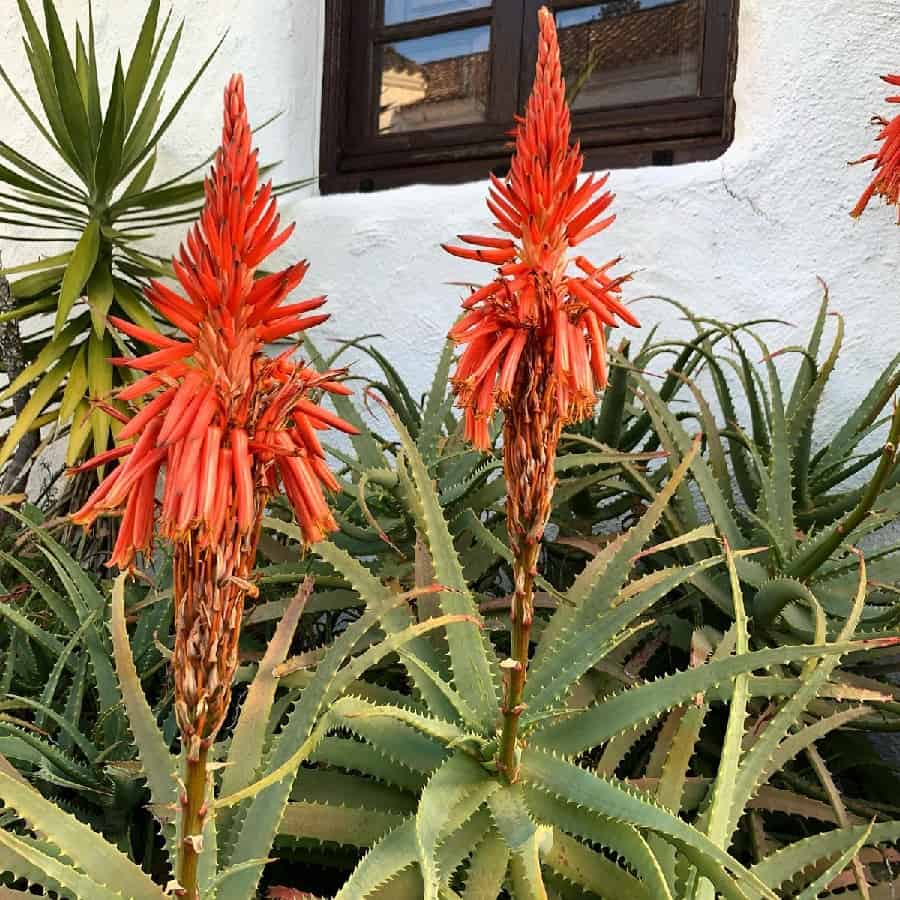
Aloe arborescens is a fantastic plant for gardens, boasting large, vibrant flowers, beautiful foliage, and an appealing shape. The most common color for its flowers is a deep orange, but they can also come in yellow or a striking combination of orange and yellow. With its attractive gray-green leaves arranged in pretty rosettes, this succulent grows into a captivating shrub that can reach heights of 6 to 10 feet.
Aloe ferox
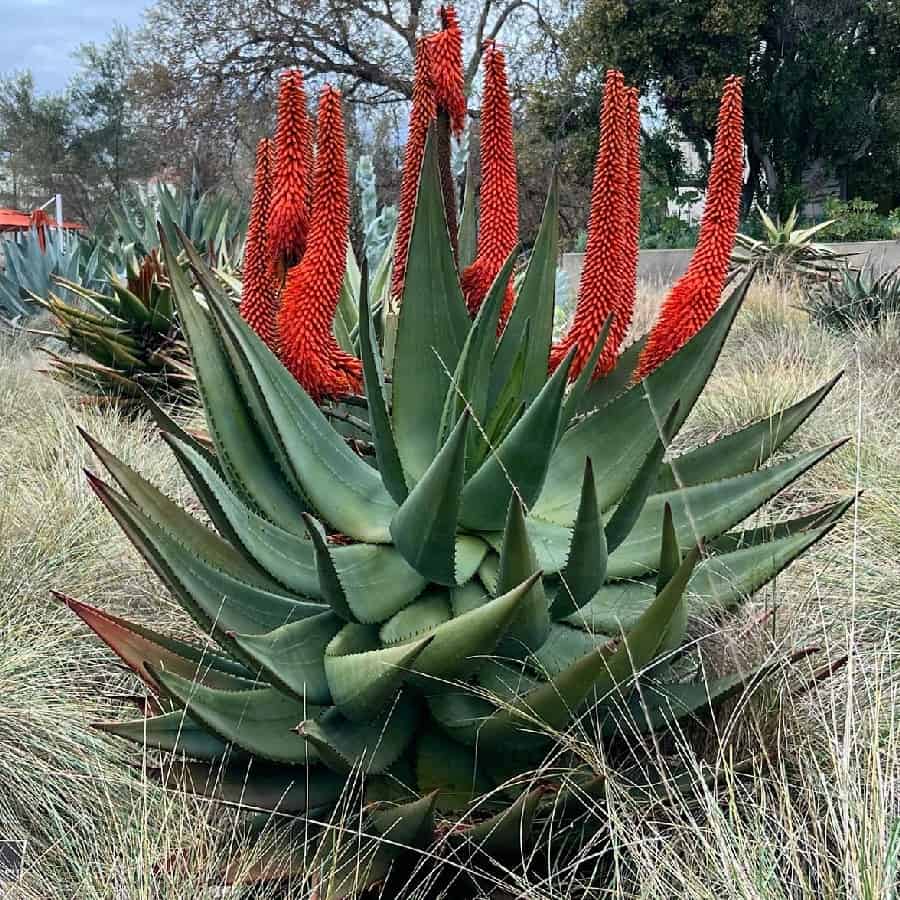
Aloe ferox stands out with its tall, rosette-shaped leaves that usually have a dull green or bluish tint. Along the edges of these leaves, you will notice clusters of spiny, reddish tendrils. This eye-catching plant produces bright yellow-orange or red flowers arranged in large, candlestick-like clusters. Depending on how it is cultivated, the height and length of this succulent can vary, but it generally reaches heights of up to 10 feet.
Aloe marlothii
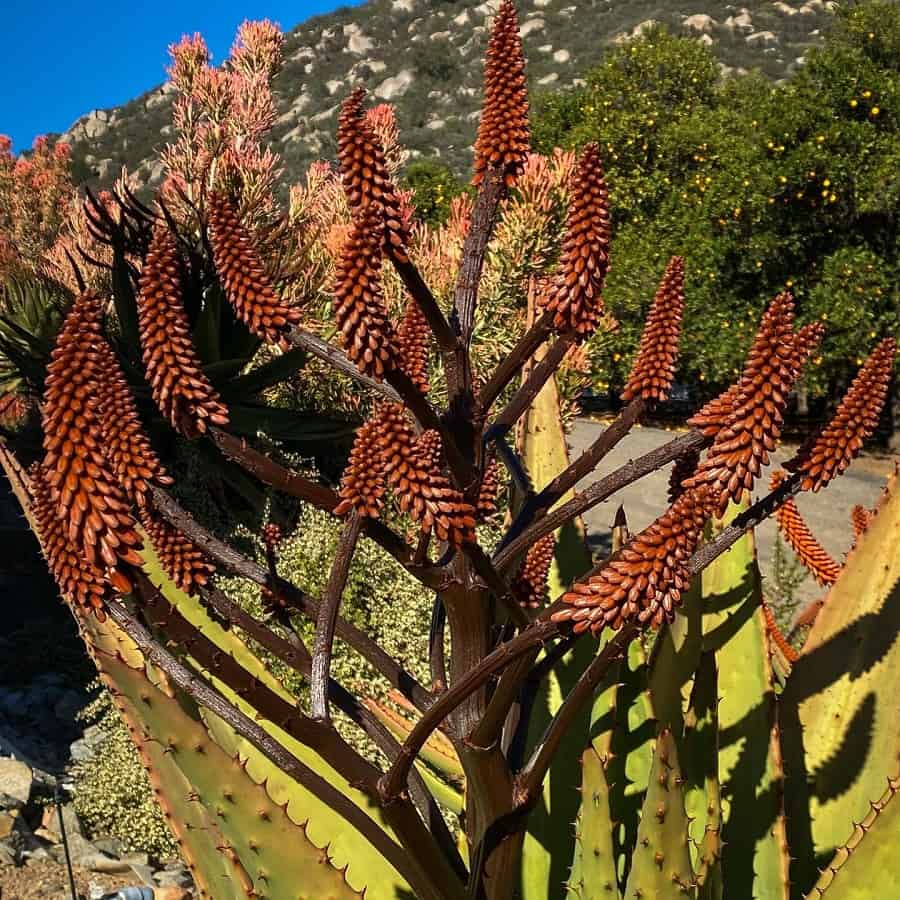
Aloe marlothii is a robust and striking succulent with a single stem that typically grows 6-10 feet tall, making a majestic statement. This versatile aloe species features large, broad succulent leaves that range in color from light green to grayish or blue-green. The leaves are covered with spines on both the upper and lower surfaces and have maroon-colored teeth with orange tips along the leaf margins. This aloe typically blooms between May and September, producing showy flowers on a branched candelabra-shaped stem in colors ranging from orange-red to yellow or bright red.
Cleistocactus icosagonus
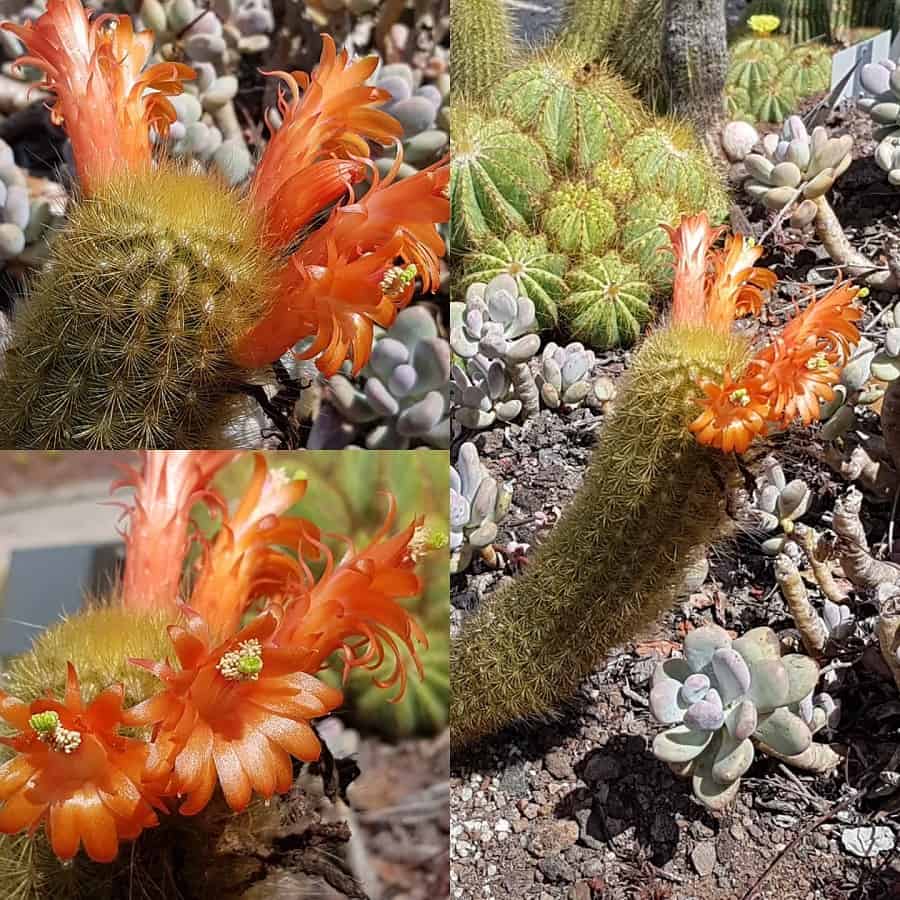
These clumping succulents have upright cylindrical stems that later spread sideways, with the tip remaining upright. Just beneath the stem ends, you’ll find solitary, striking reddish-orange tubular flowers with flared mouths. The combination of red-orange blossoms and golden spines creates a dramatic impact.
Conophytum frutescens
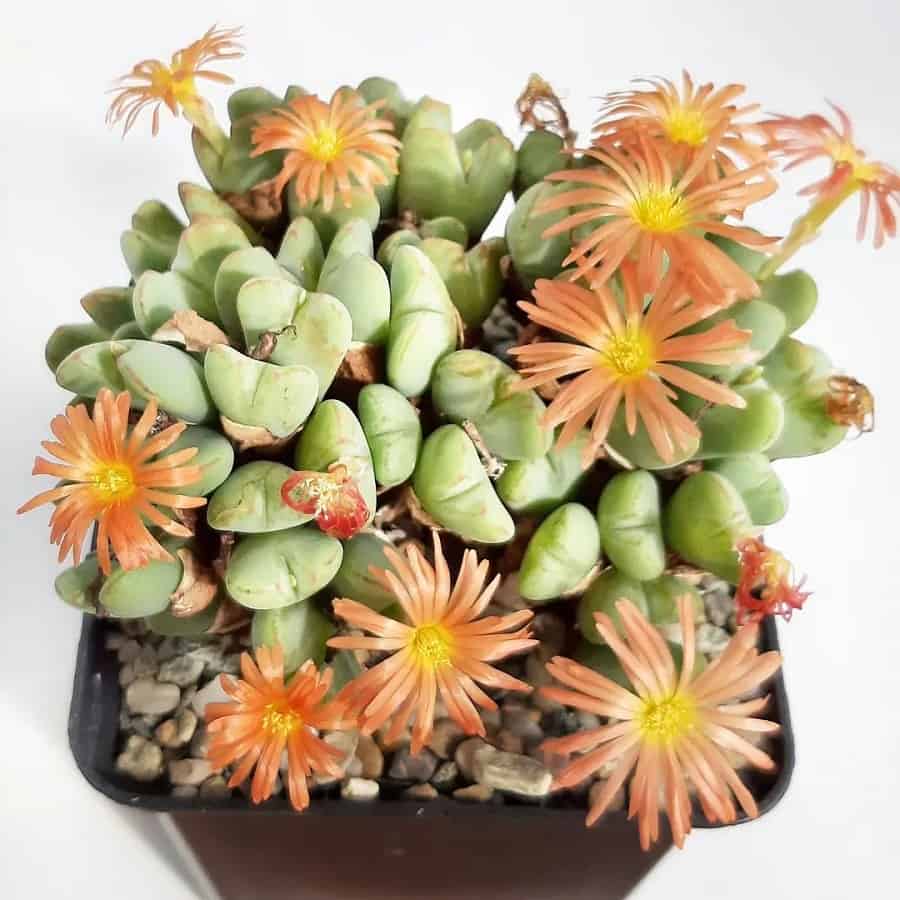
Conophytum frutescens is known for its vibrant copper-colored flowers. This striking succulent forms small rosettes of succulent leaves at the base, growing upright to a height of just 5-10 inches. In the fall, vibrant coppery orange flowers appear in clusters near the top of the plant. The edges and keels between the lobes of its leaves are adorned with dull purple streaks and speckled with spots in shades of grey-green, yellowish-green, or turquoise.
Conophytum loeschianum
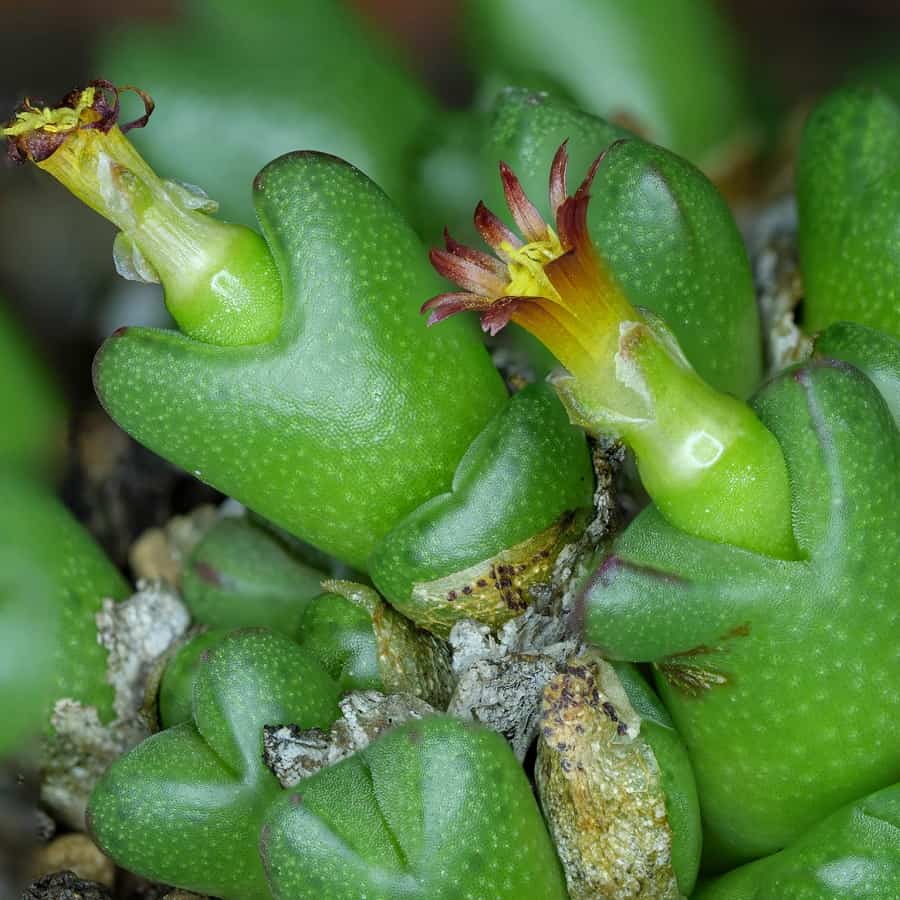
Cophytum loeschianum is a unique succulent that forms small, densely packed mats or domes. With its vibrant orange flowers and petals that range in color from red to white, this succulent is truly remarkable in its appearance. Reaching a height of less than 0.5 inches, its compact growth, sharp glabrous leaves, keeled bodies, and vibrant orange flowers make it truly captivating. The petals can vary in color depending on the specific variety.
Cotyledon eliseae
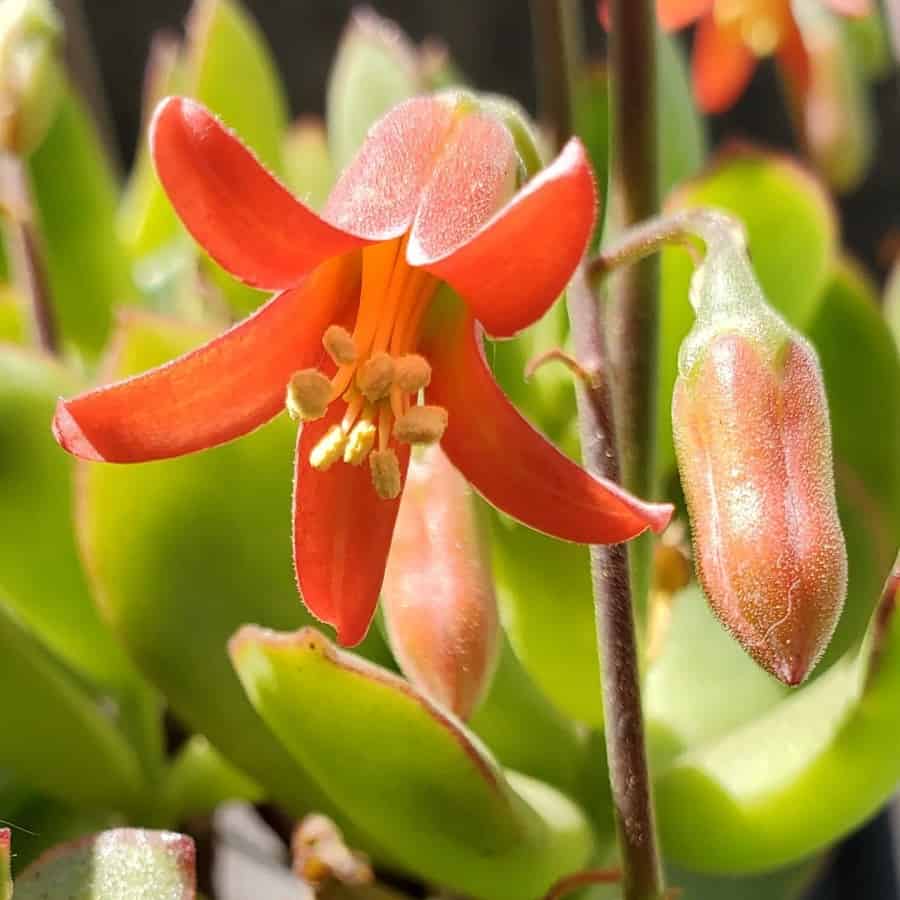
This highly attractive, rounded, and compact shrublet grows up to 8 inches tall. As one of the most flower-filled cotyledons, it features lush green foliage and nodding, beautiful orange-red blooms that last a long time. Its sticky leaves and diminutive size set it apart from other species.
Cotyledon orbiculata
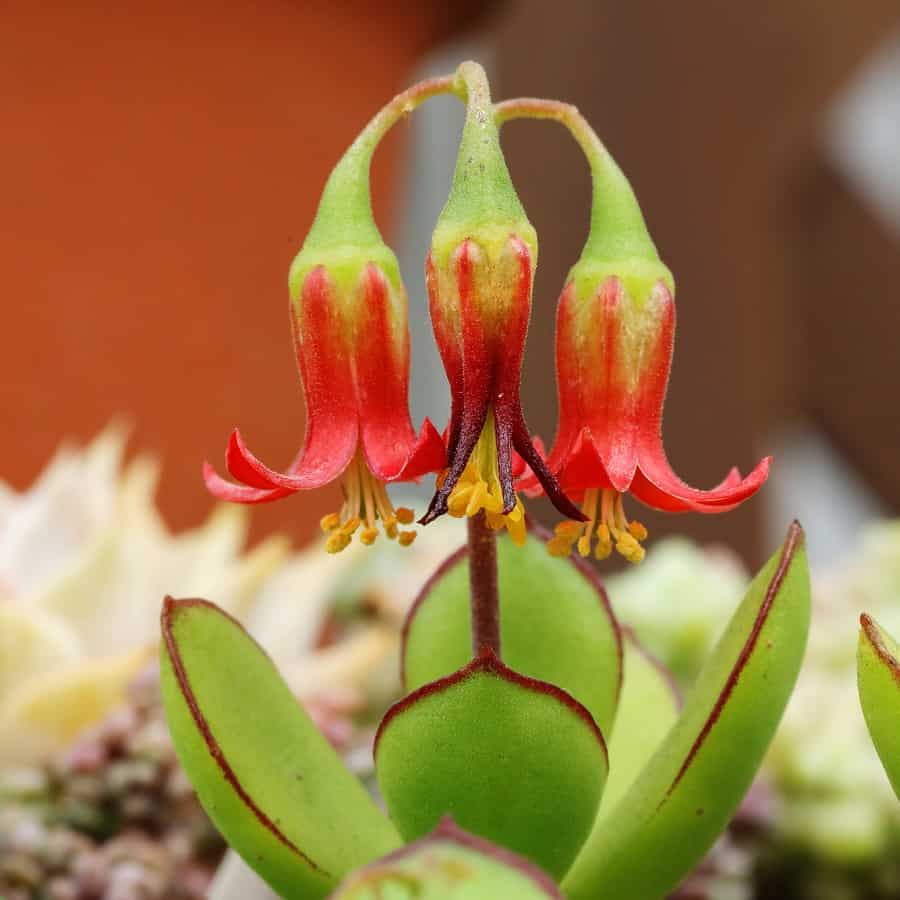
Cotyledon orbiculata is an evergreen, low-growing succulent with distinct round leaves and vibrant orange-yellow flowers. It produces clusters of bright orange-yellow tubular flowers from late spring to early summer, bringing splashes of color and texture to its natural habitat. The height of Cotyledon orbiculata reaches just 4 inches, and its leaves have a gray-green hue.
Cotyledon pendens
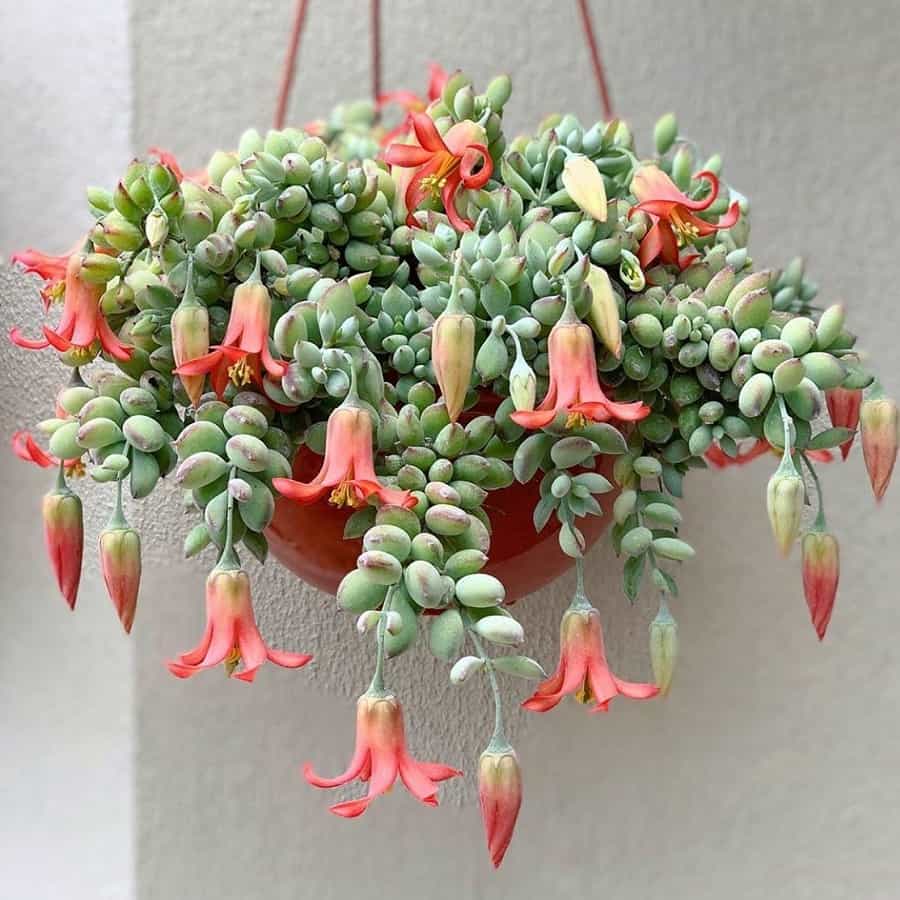
Cotyledon pendens is a unique shrublet succulent with hanging branches and blooms, forming a dense, 24-inch curtain-like plant. Its roots are not succulent but rather fibrous. The leaf surface has a pale gray-green color due to the powdery bloom, while the leaf margin features a lovely scarlet hue. This variety blooms profusely throughout the summer, displaying bell-shaped orange-red flowers that enhance its aesthetic appeal.
Cotyledon tomentosa
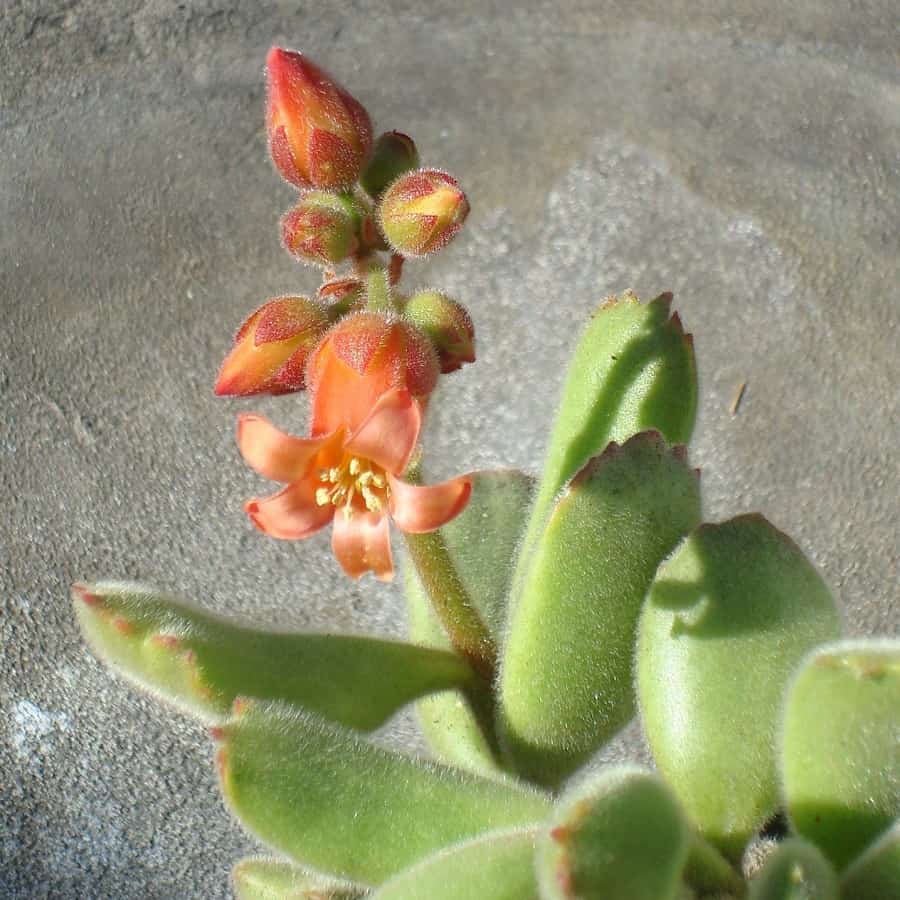
Cotyledon tomentosa is a low-growing succulent shrublet that produces attractive orange flowers. It can grow up to 12-28 inches in height and have a diameter of 12-20 inches. Like all tomentose plants, it is covered in a downy layer on its leaves, flowers, and stems. The leaves, ranging in size from a grape to a thumb, feature red tips and have a plump and soft texture, resembling the fluffy paws of a young animal. In spring, it produces large bell-shaped orange flowers.
Cotyledon undulata
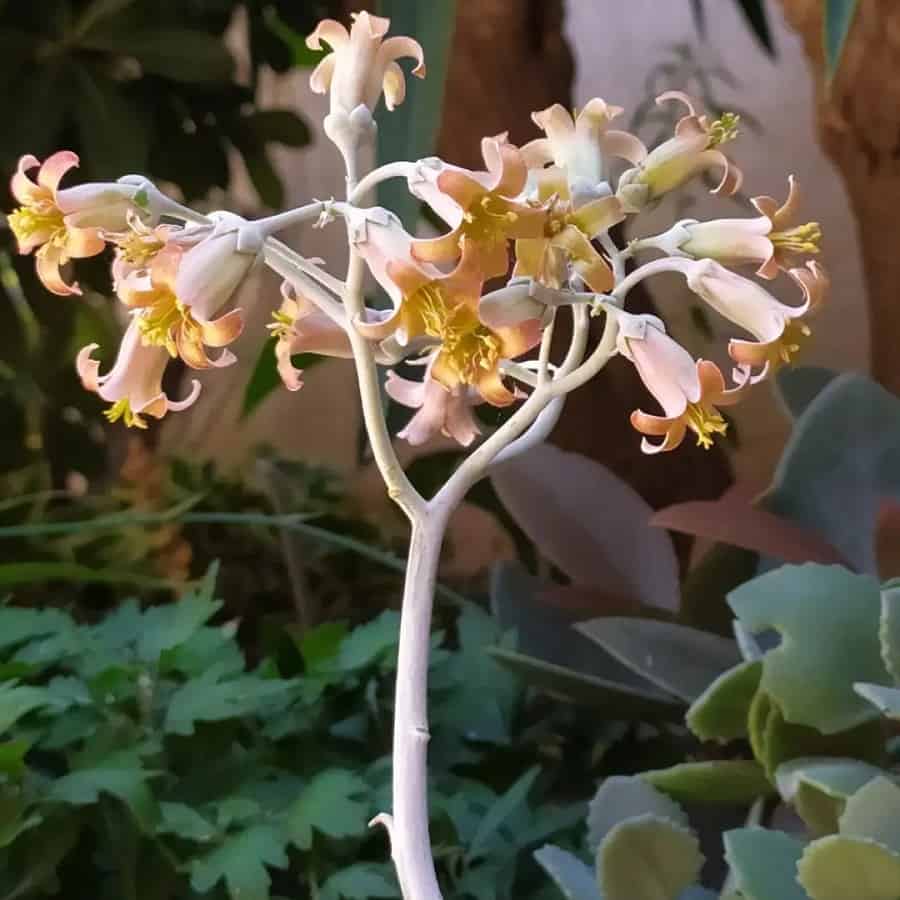
Cotyledon undulata, also known as ‘the wave-leaved succulent,’ belongs to the Crassulaceae family. It is an evergreen succulent shrublet with stubby, undulating leaves that have a yellow-green color and grow to heights of 20 inches. During late summer to early fall, it produces clusters of vibrant orange-yellow bell-shaped flowers, adding a unique and colorful touch to your landscape.
Crassula capitella ‘Campfire’
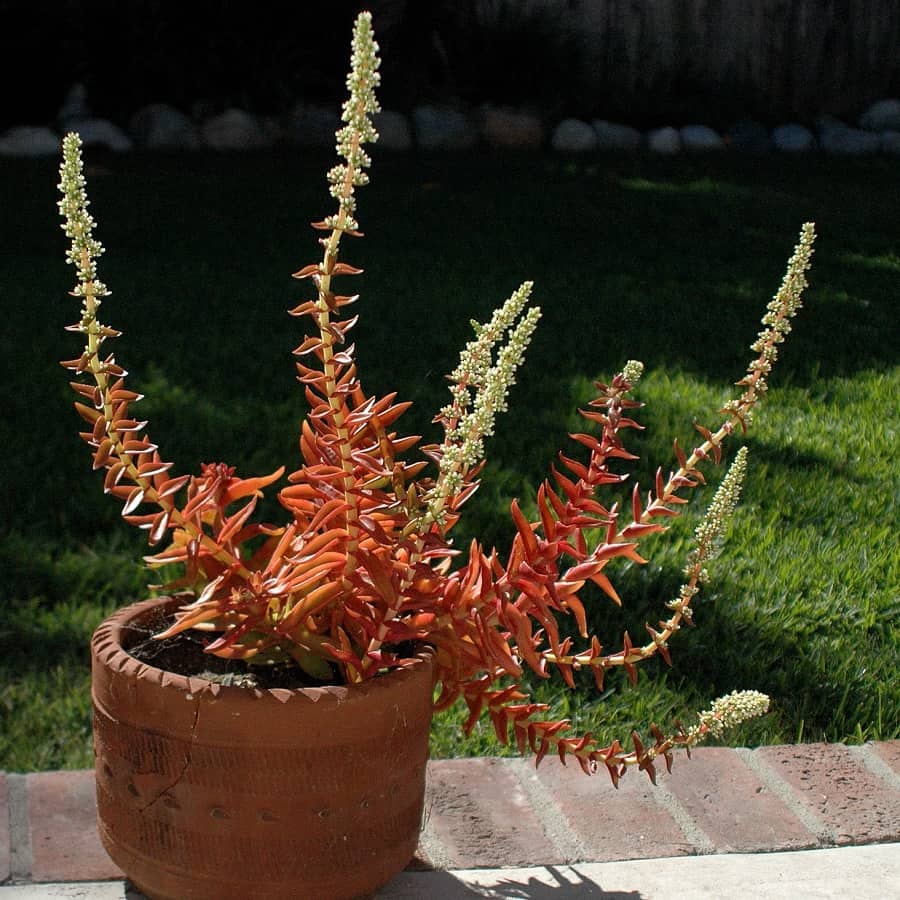
Crassula capitella ‘Campfire’ is the perfect succulent to add a burst of vibrant color to any collection. This low-growing succulent features an eye-catching orange-red hue, with leaves displaying a striking flame pattern. The height of ‘Campfire’ reaches just 4 inches, and its distinctive appearance, dense foliage, and long-lasting blooms make it a fantastic addition to any landscape.
Crassula columnaris
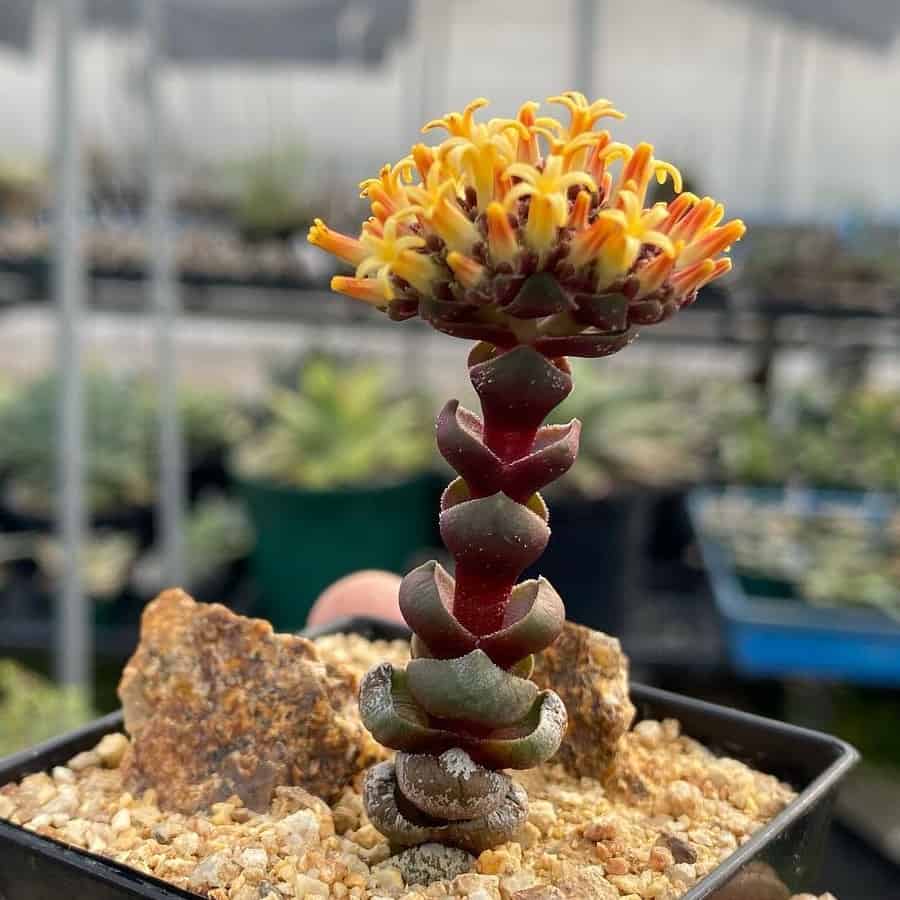
Crassula columnaris is an appealing columnar-shaped succulent that bears yellowish-orange flowers. It has tightly packed green leaves that grow in circular patterns along the stems, reaching a height of up to 12 inches. The small yellowish-orange flowers appear during the spring months, providing a unique splash of color to any landscape.
Crassula perfoliata var. falcata
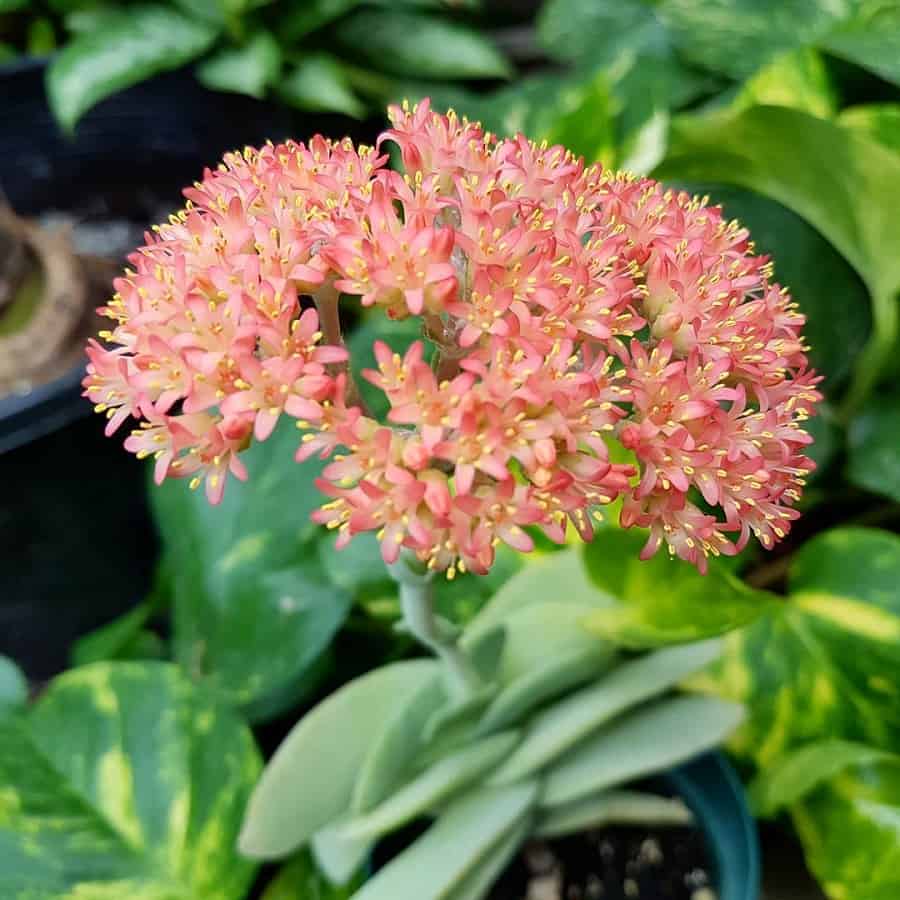
Crassula perfoliata var. falcata is a low-growing succulent with beautiful orange-red flowers. It grows in clumps, reaching heights of up to 24 inches, and has serrated leaves arranged in pairs around the stem. Its showy blooms appear from mid to late spring. In the middle of June, masses of tiny scarlet-red flowers clustered tightly together rise above the foliage. It takes over a month for the flowers to fully open.
Dudleya brittonii
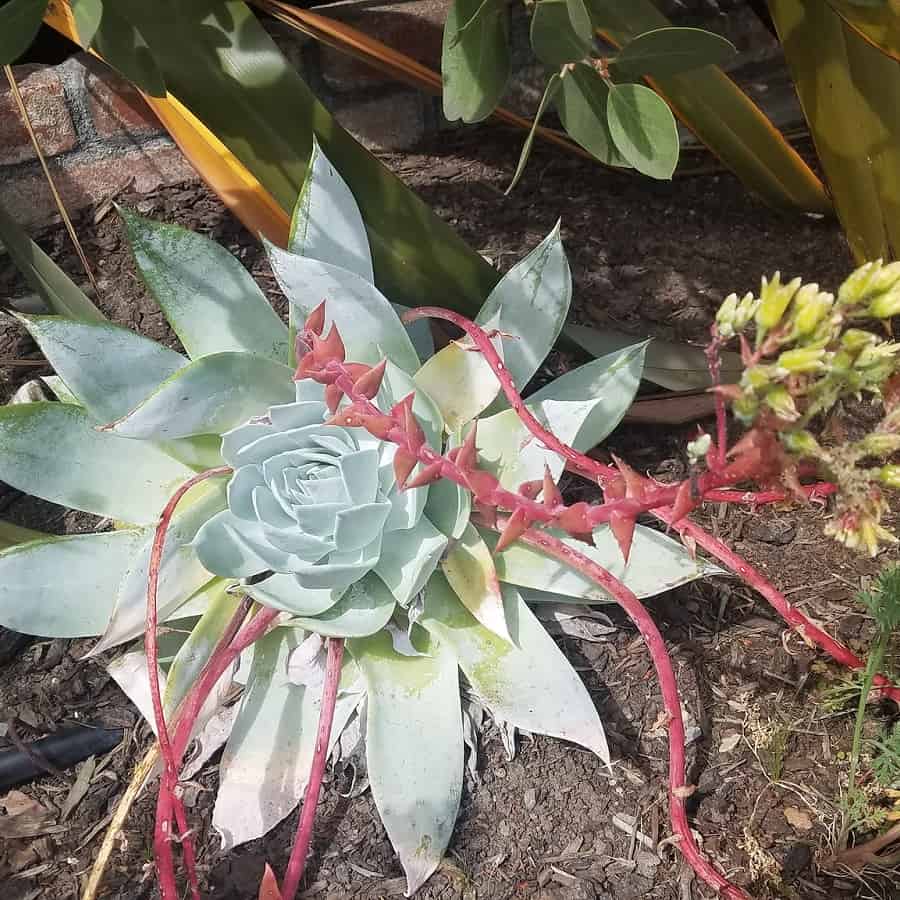
Dudleya brittonii is a cool-looking perennial succulent known for its variable features. It has spoon-shaped, oblong to lanceolate leaves that come in colors ranging from white to silver-grey. These leaves measure about 12 to 18 inches in diameter. In the late winter to early spring, this plant puts forth long, reddish-pink stems that can reach up to 2 to 3 feet. At the top of these stems, you’ll find beautiful pale yellow flowers.
Dudleya saxosa
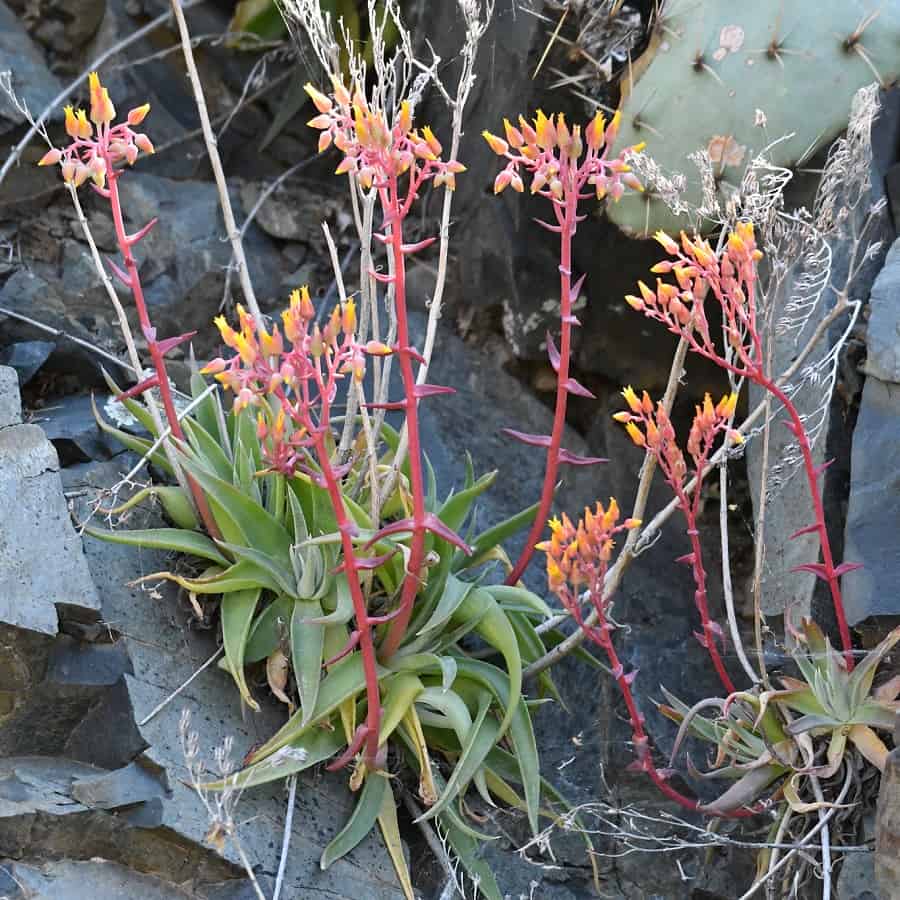
The Dudleya saxosa plant forms a circular shape with its fleshy leaves, which can be flat and blade-like or a bit rounded. It grows upright stems that are usually dull pink to red and may have a touch of light green. The stems support compact bunches of vibrant yellow blooms.
Echeveria ‘Doris Taylor’
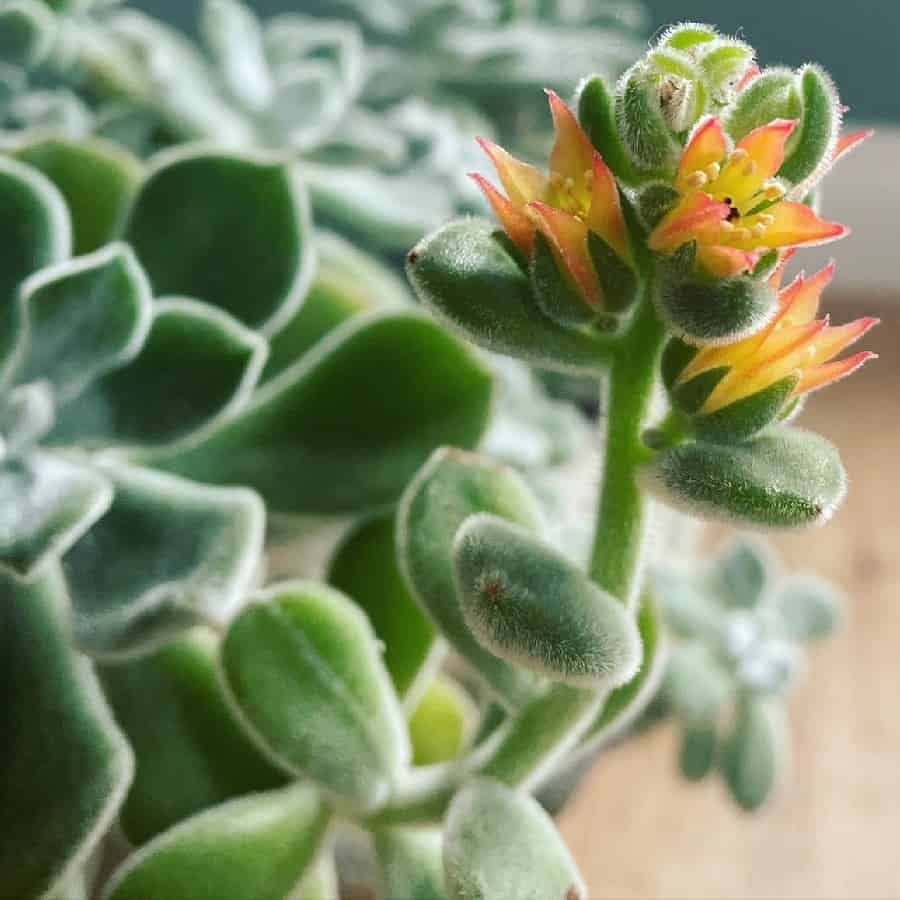
Echeveria ‘Doris Taylor’ is a small succulent that spreads horizontally and has short stems. It can grow up to 2 inches tall. The entire plant, including the blossoms, is covered in shiny hairs. It produces yellow flowers from spring through fall, and these flowers have red on the outside with yellow accents.
Echeveria atropurpurea
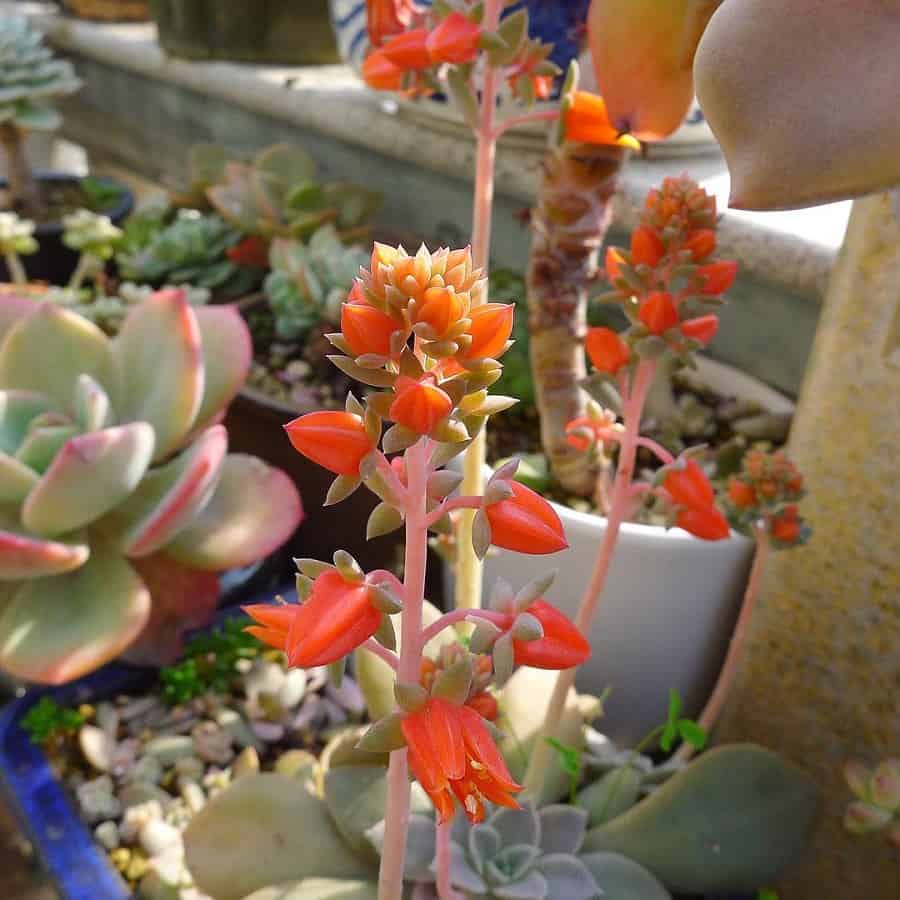
Echeveria atropurpurea is a popular and eye-catching succulent. It has short but strong stems and oblong leaves that are dark purple. On top of these leaves, there is a powdery bloom that gives it a unique appearance. During winter, this plant showcases stunning pinkish-orange blossoms. When fully grown, its rosette can reach a width of about 10 to 16 inches and has 20 leaves.
Echeveria bifida
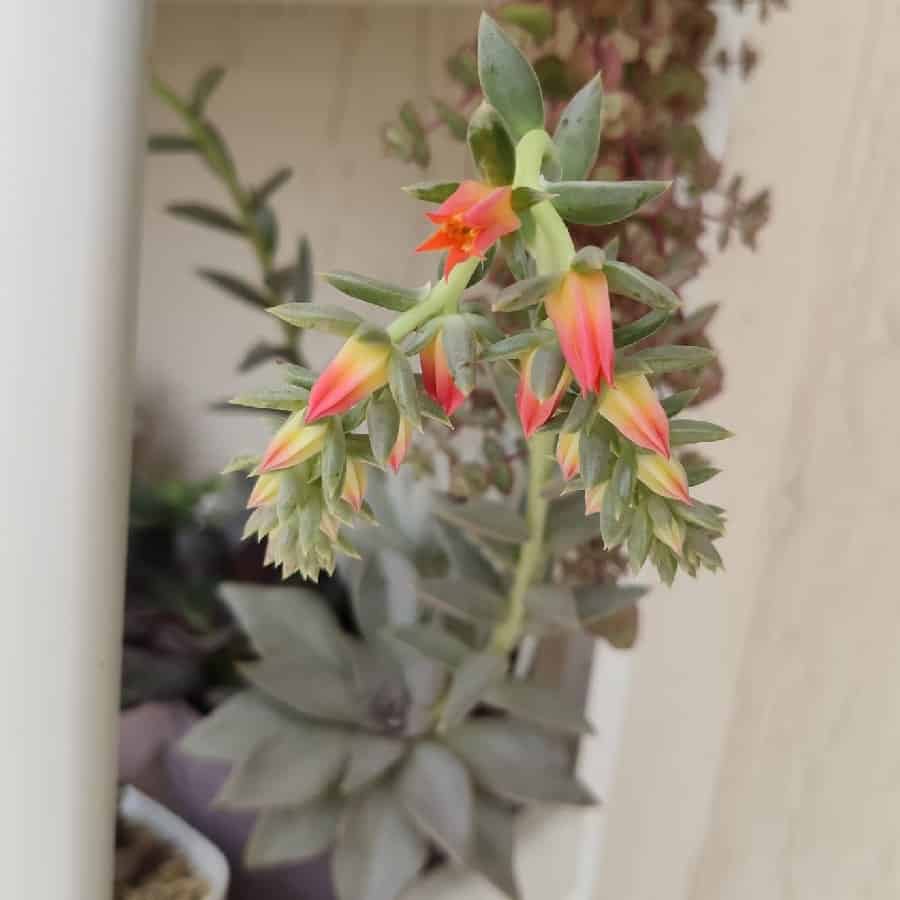
Echeveria bifida, also known as Branched Flower Hens and Chicks, is a beautiful succulent with pale greyish-brown colors. It forms rosettes with leaves that curve like spindles and slender flower stalks that hold bell-shaped pinkish-orange blooms. This species is quite varied and can be challenging to define accurately.
Echeveria cante
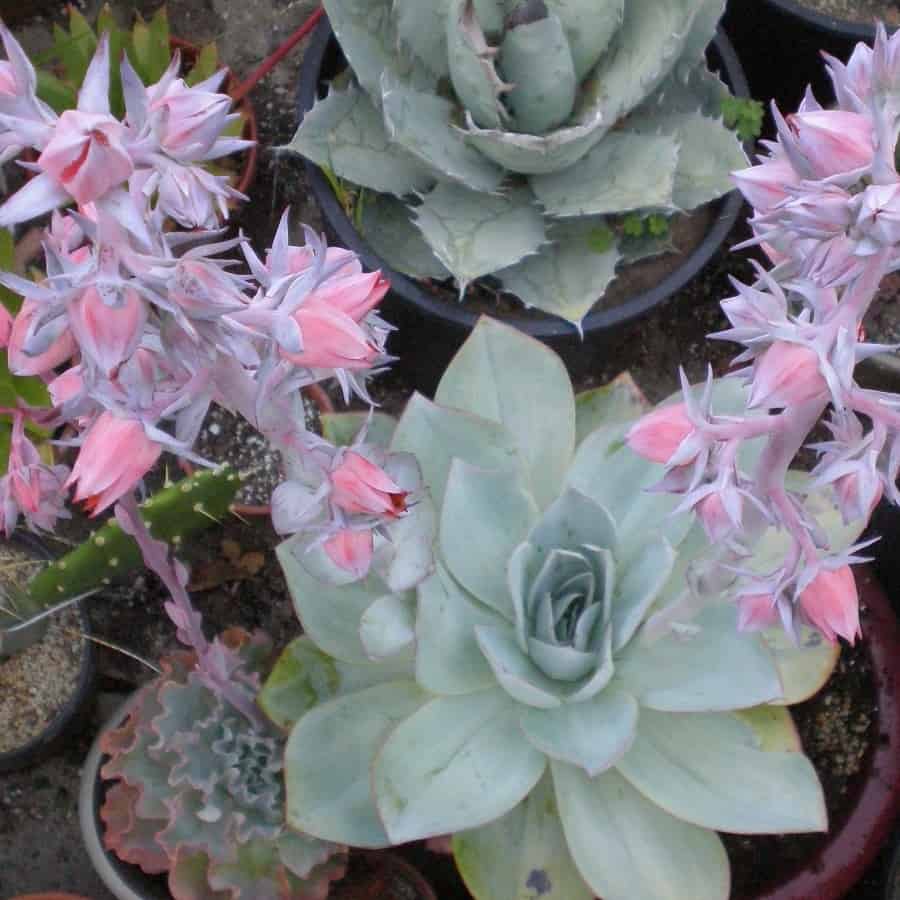
The Echeveria cante plant stands out with its thick and narrow leaves, which are often longer compared to other species. The flowers of this plant are notably distinct as well. The tube of the flowers is a powdery greyish-lavender color, and the petals are a powdery orange-pink on the outside and yellowish on the inside. The flowers themselves are about 23 mm long.
Echeveria cv. Bombicina
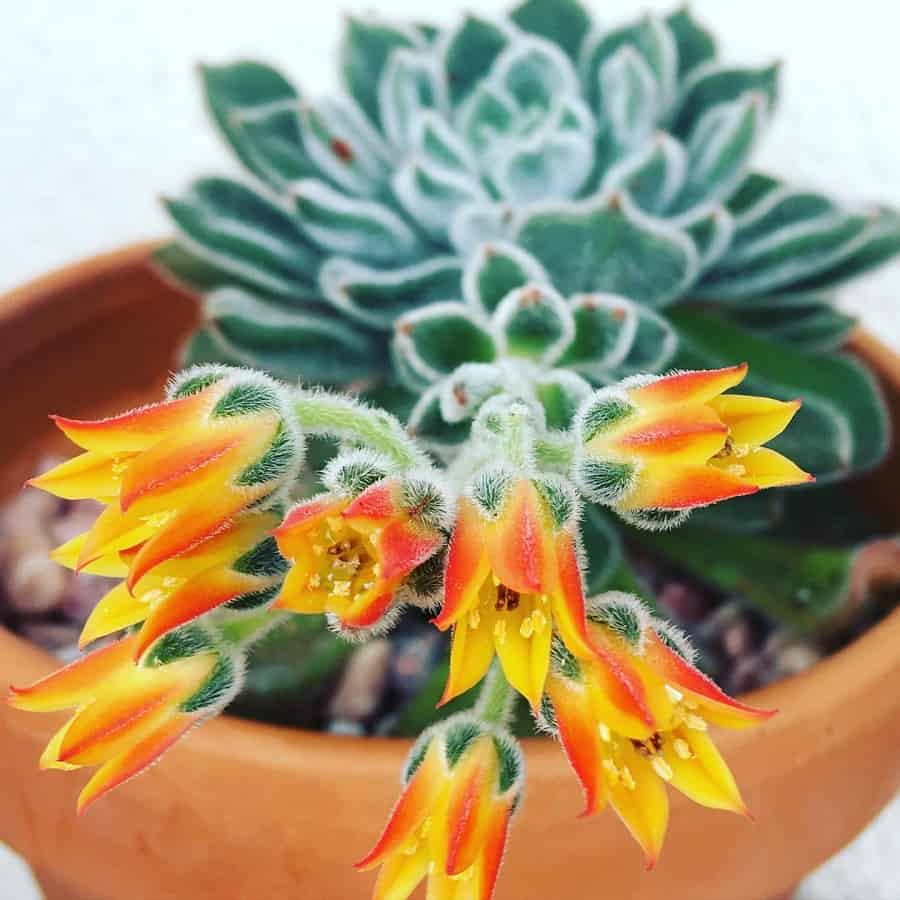
Echeveria cv. Bombicina is a stunning succulent with pale grey-green leaves that are spoon-shaped and have prominent red edges. During late summer or autumn, it produces striking orange-yellow flowers, making it an excellent addition to any garden. These flowers are rich in nectar, attracting hummingbirds and other pollinators.
Echeveria diffractens
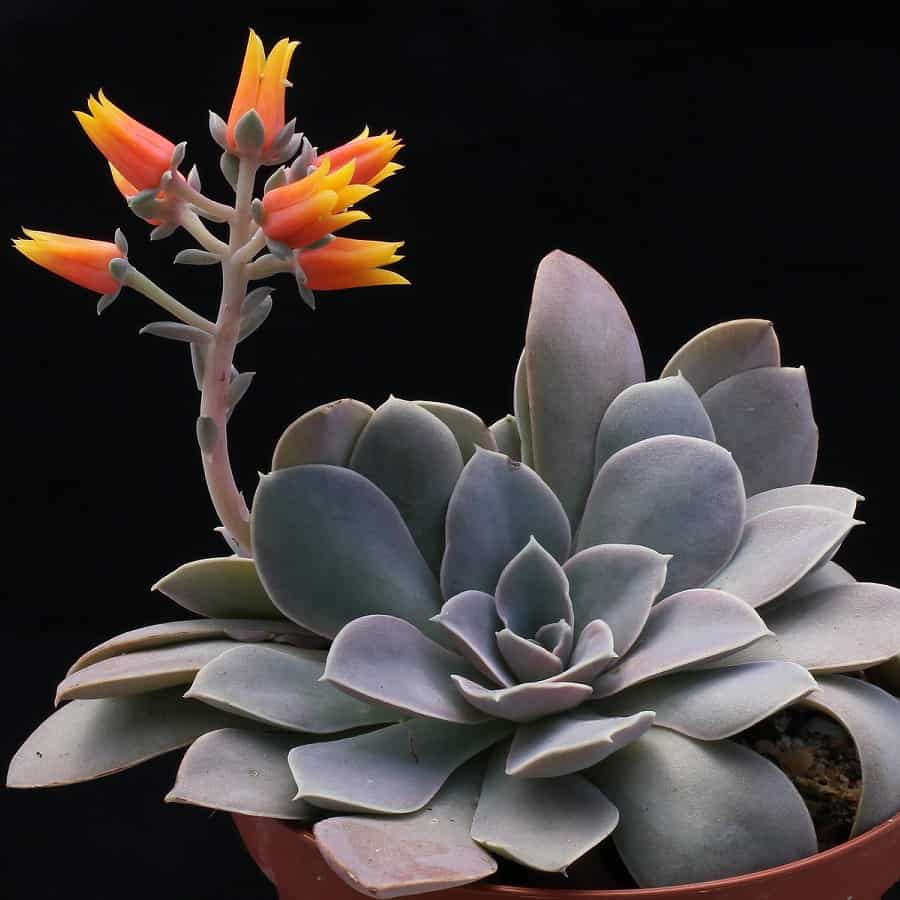
Echeveria diffractens is a visually stunning succulent that forms small, clump-like groups of plants. It has thick, long, pale-green curved leaves and bright yellow or pale orange flowers. Its rosette shape makes it perfect for rock gardens or as an accent in containers. You’ll see beautiful yellow or pale orange blooms on short spikes above the foliage, mainly during late spring to early summer.
Echeveria laui
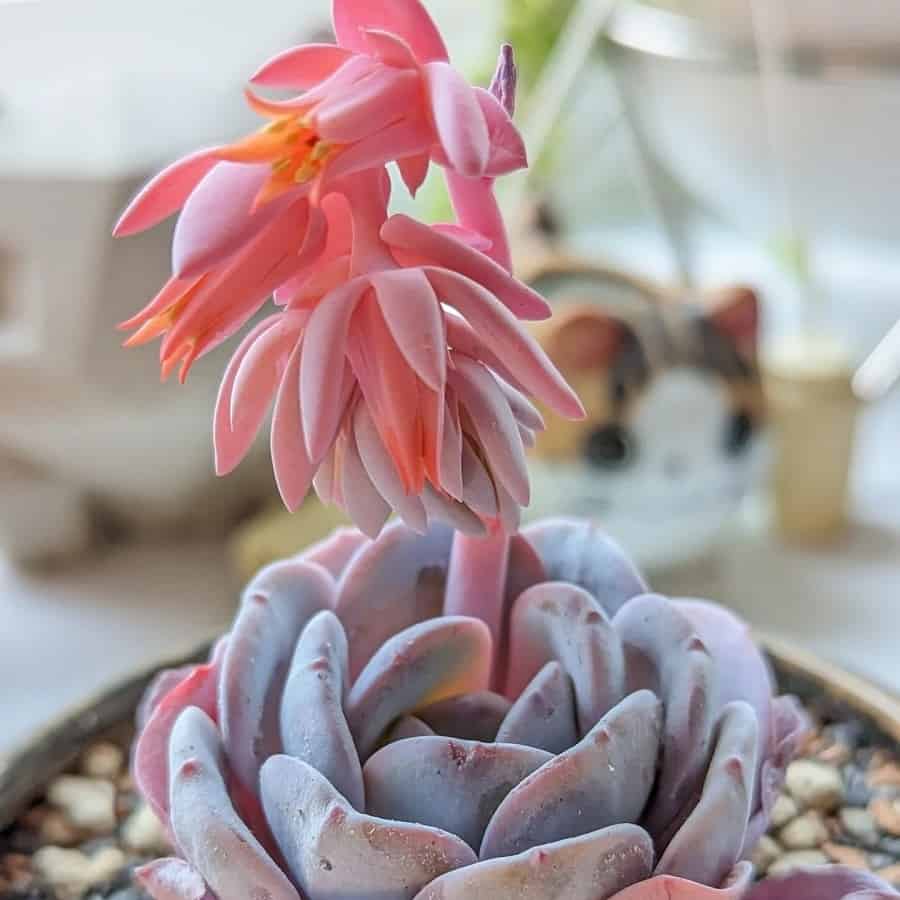
Echeveria laui is an attractive succulent with a rosette shape and pale green to grey-green leaves. In late spring and early summer, it produces clusters of pinkish-orange blooms on tall, upright stems. These flowers have star-shaped structures with five petals each.
Echeveria lilacina
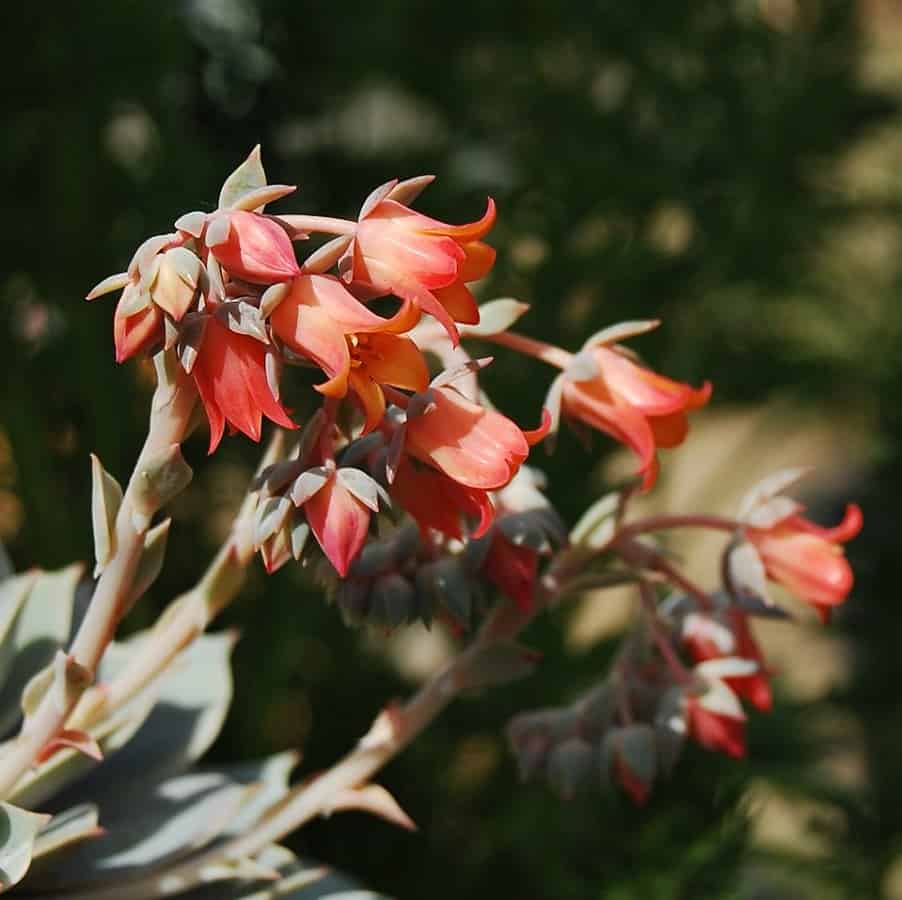
Echeveria lilacina is a succulent that catches the eye with its pale green or silvery gray, spoon-shaped leaves. It grows tall stems with clusters of pinkish-orange blooms. You can expect these flowers to bloom from late winter to early spring. They appear in short, curved clusters at the top of long reddish stems.
Echeveria lutea
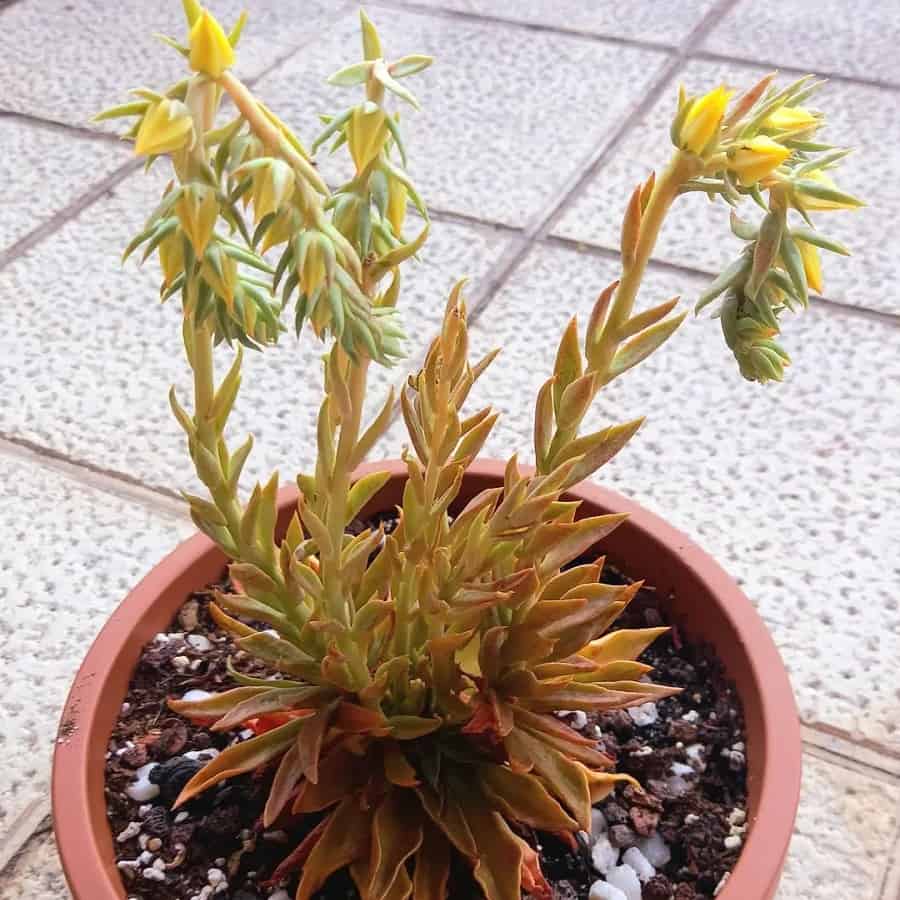
Echeveria lutea is a striking succulent with glossy green leaves that form a rosette shape. It also grows tall, upright stems covered in yellowish-orange flowers. This plant blooms in late spring or early summer, and its star-shaped flowers have five petals per bloom. The vibrant blossoms create a beautiful contrast against the deep green foliage.
Echeveria pulv-oliver
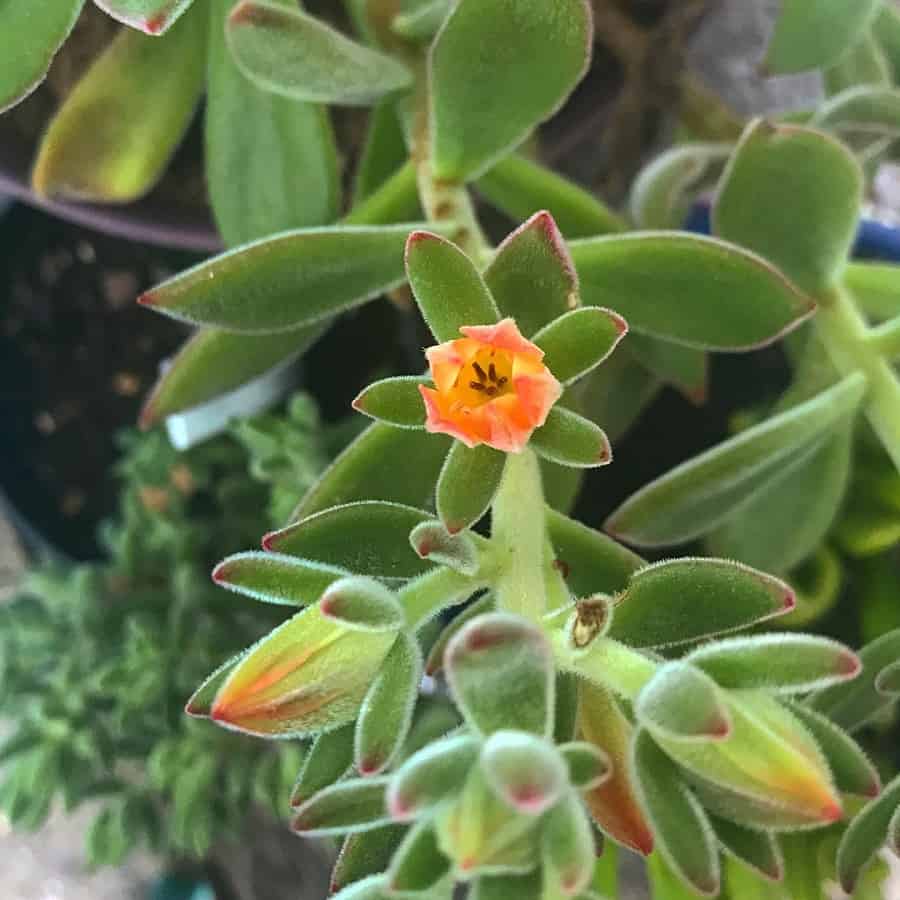
Also called Red Echeveria, Echeveria pulv-oliver has green leaves with a slightly hairy texture. Its rosettes have an appealing look and can reach a foot in diameter. The leaves feature sharp edges with a crimson hue that grows at the ends of the branches. This succulent produces orange flowers on the outside and yellow flowers on the inside.
Echeveria purpusorum

Echeveria purpusorum is a visually stunning succulent with thick, curved leaves that vary in color from green to pinkish-red, adorned with white stripes. During late spring and early summer, tall flower spikes covered in yellowish-orange blooms emerge.
Echeveria runyonii cv. Topsy Turvy

‘Topsy Turvy’ is a captivating succulent that stands out with its colorful and wavy leaves. Its vibrant foliage ranges from green to pinkish-red and has a unique up-and-down pattern, giving it the name “Topsy Turvy.” In late summer or early fall, this plant showcases tall arching racemes with stunning bright orange, apricot, and pink flowers.
Echinopsis chamaecereus
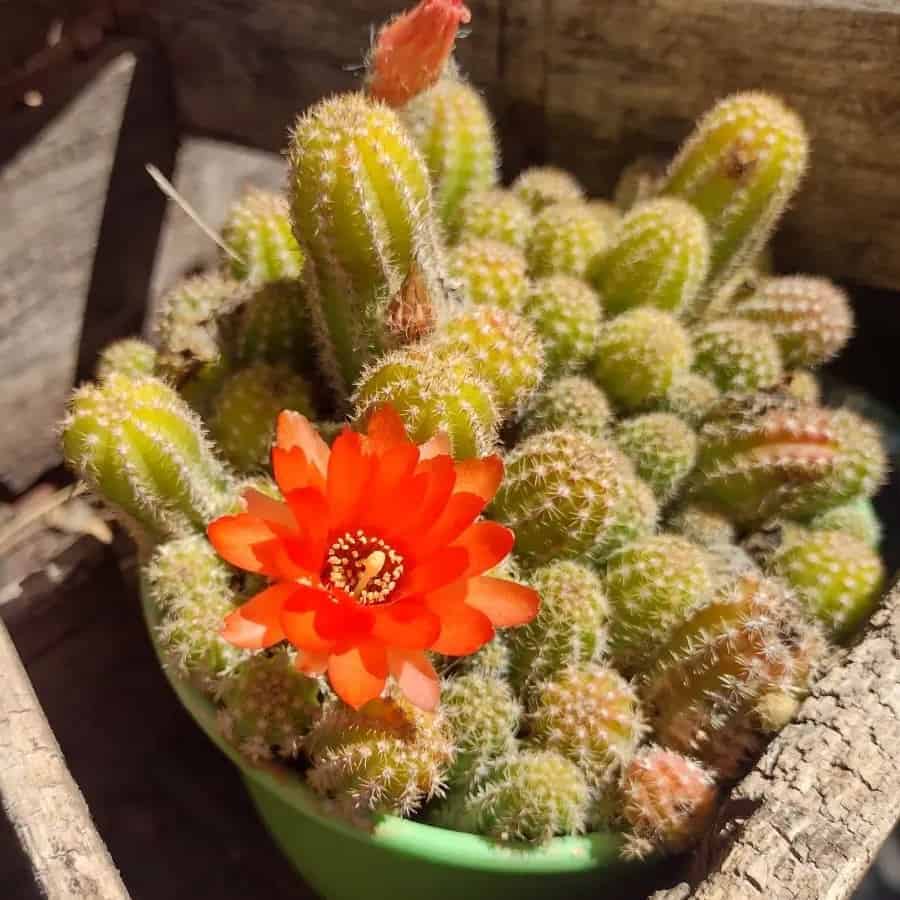
Echinopsis chamaecereus is a small cactus that grows close to the ground. It has small, cylindrical stems that are grey-green and covered in white hairs. This cactus produces bright pink flowers with yellow throats and has a unique scent. These flowers open at night, making this plant an excellent choice for adding a touch of evening color to your garden.
Fenestraria rhopalophylla subs. aurantiaca cv. Fireworth
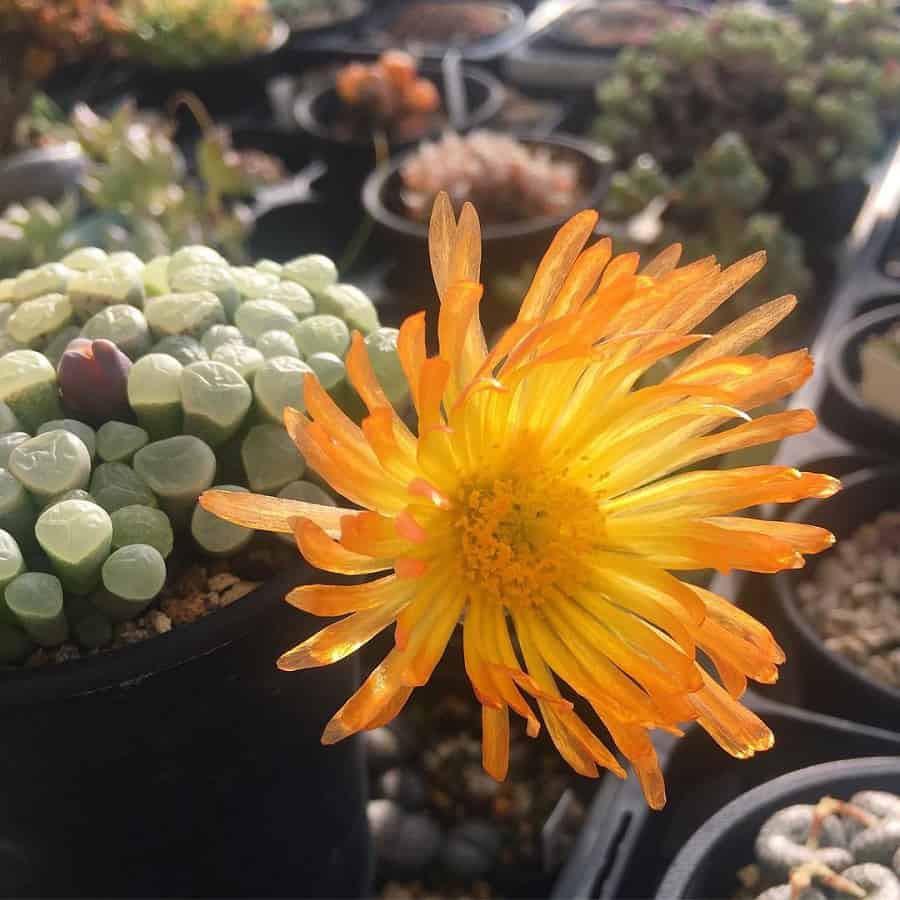
This succulent is truly eye-catching with its long, flat stems covered in sharp spines. During late spring to early summer, the plant puts forth beautiful bright orange flowers at the ends of its branches. These colorful blooms have yellow centers and attractive petals that attract hummingbirds and other pollinators.
Ferocactus cylindraceus
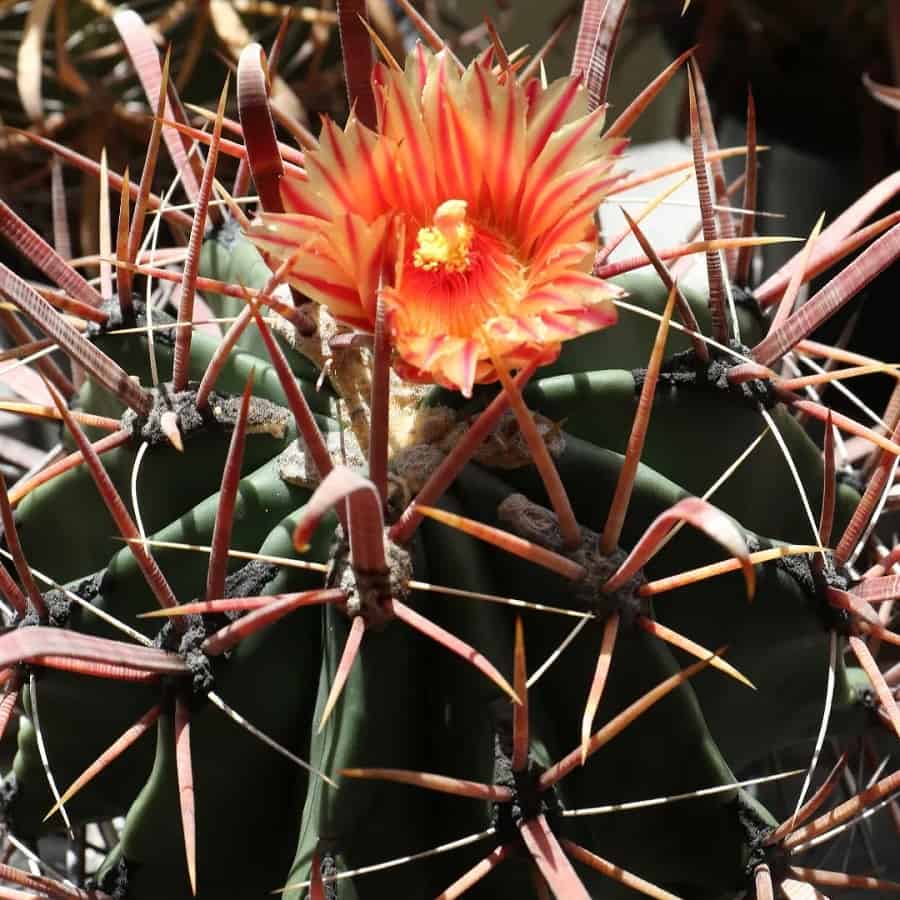
Ferocactus cylindraceus is a cactus with a barrel-like shape. Its stems can be blue-green or yellowish-green and are covered in spines. In the late summer, this cactus produces showy flowers in orange, red, or yellow hues, followed by small fruits.
Graptoveria cv. Fred Ives
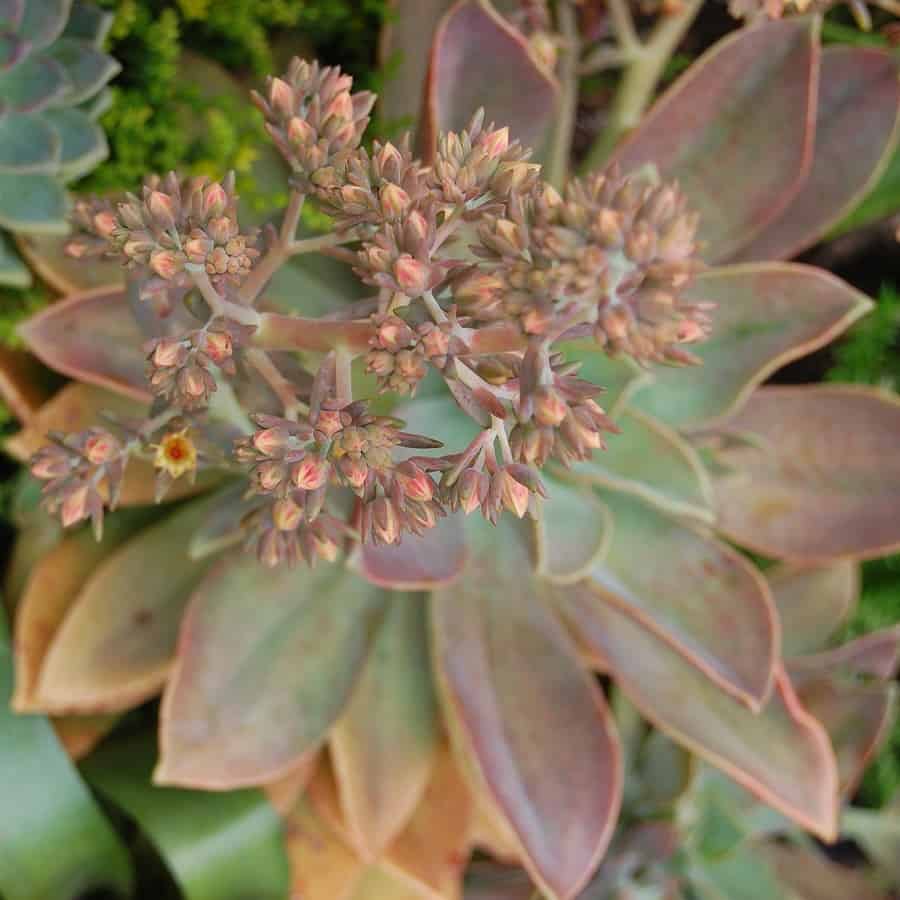
Graptoveria cv. Fred Ives is a stunning succulent that forms rosettes with white to pinkish-yellow foliage. During late spring through early summer, the plant grows tall stems topped with clusters of reddish-orange flowers. These bright blooms contrast beautifully against the variegated gray and green leaves.
Hereroa puttkameriana
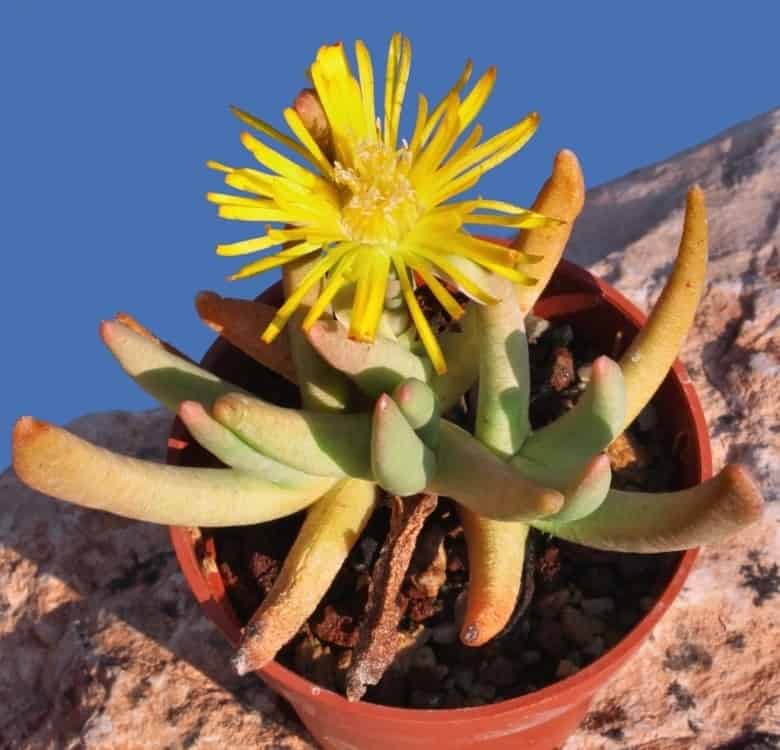
Hereroa puttkameriana is a great-looking succulent with soft, thick leaves that have a waxy texture. Its tall stems are covered in spines. In the late fall and winter, this plant produces bright yellowish-orange flowers at the top of its long reddish stems. These vibrant blooms create a lovely contrast against its silvery green foliage.
Kalanchoe beharensis
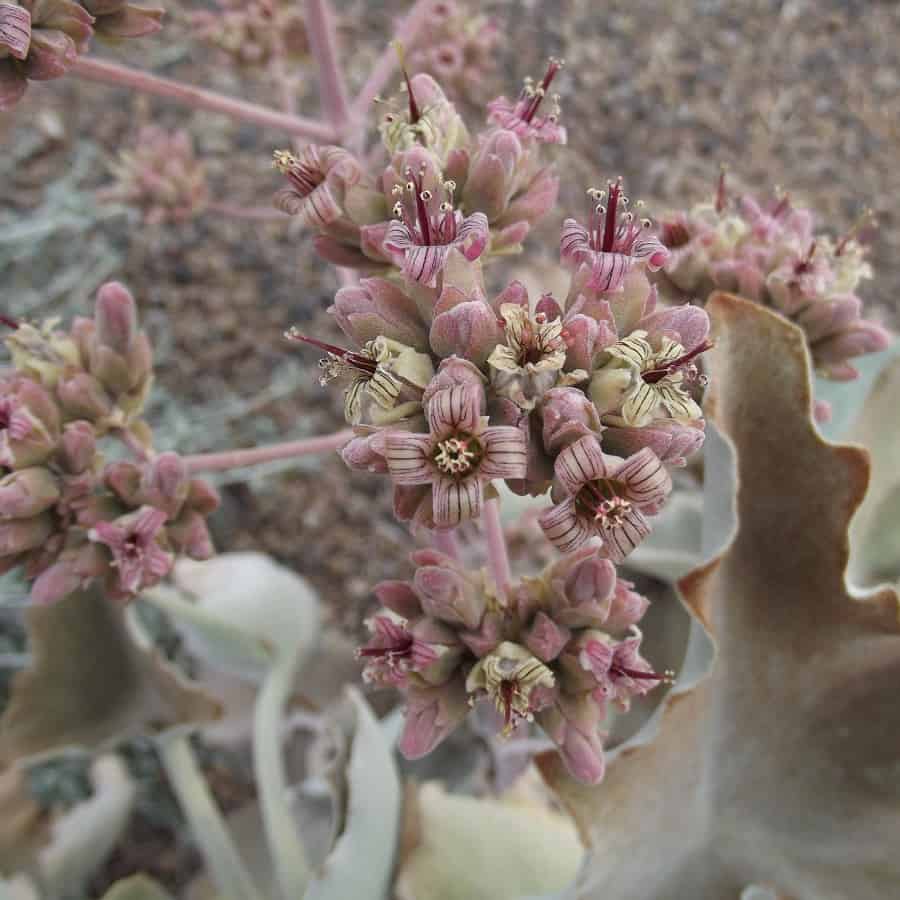
The Kalanchoe beharensis is a spectacular succulent with large, fleshy leaves that range in color from grey-green to brown. It blooms in late winter and spring with showy clusters of orange-red or yellow bell-shaped flowers. These lovely flowers have four petals each and can grow up to two inches in height.
Kalanchoe blossfeldiana ‘Orange’
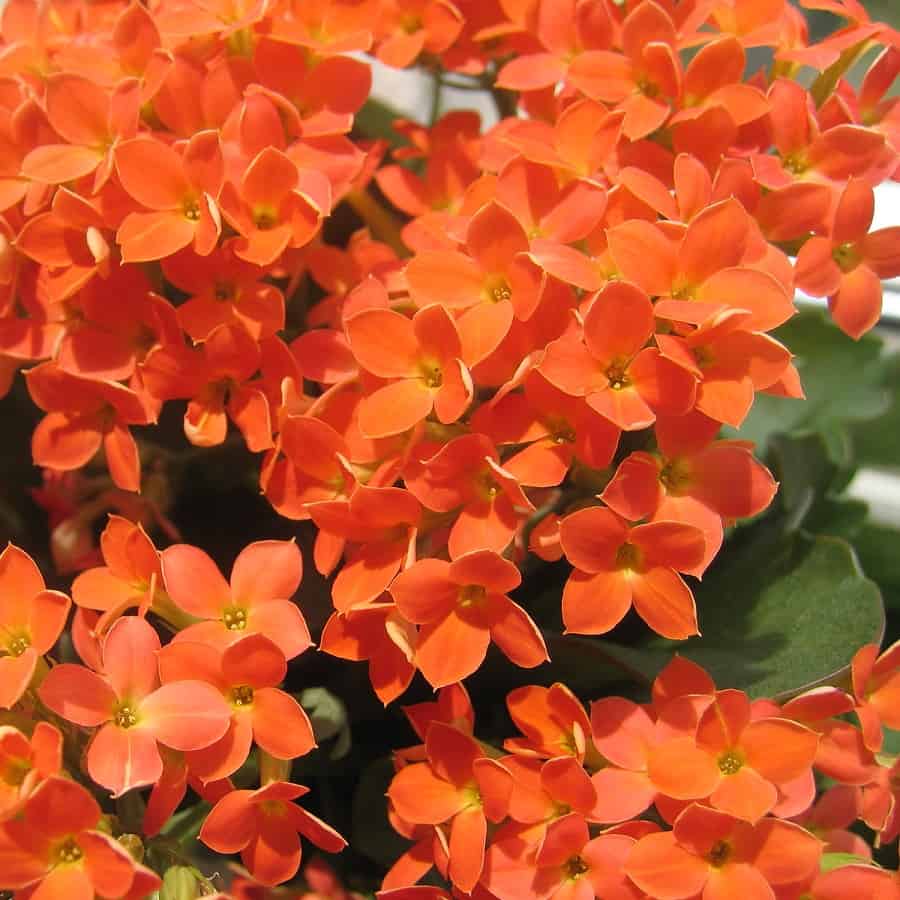
Kalanchoe blossfeldiana, also known as Christmas Kalanchoe, is a bushy succulent that reaches a height of 16 inches. It has oval-shaped fleshy leaves. In the early spring, it produces terminal panicles of tubular orange flowers that spread their lobes. These flowers can have either four-lobed tubular or bell-shaped structures, and the foliage can be simple or pinnately lobed.
Kalanchoe bracteata
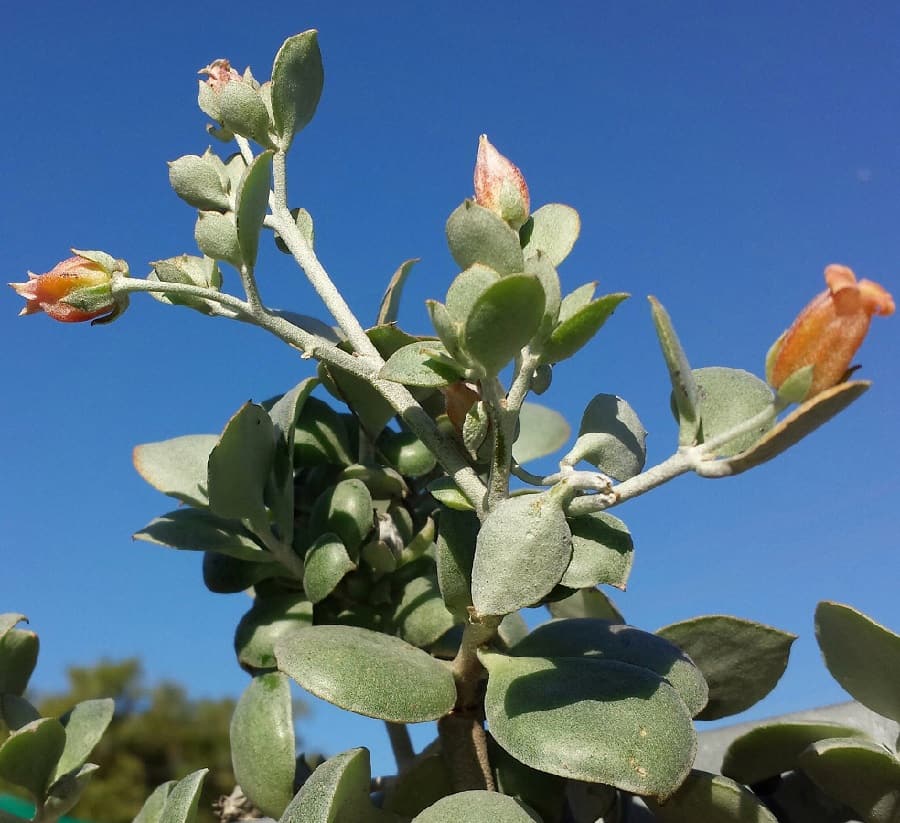
Kalanchoe bracteata, commonly known as the Silver Teaspoons, is a stunning succulent with large, waxy leaves and tall stems. In late spring to early summer, it produces fragrant orange-red flowers that attract pollinators to your garden.
Kalanchoe crenata
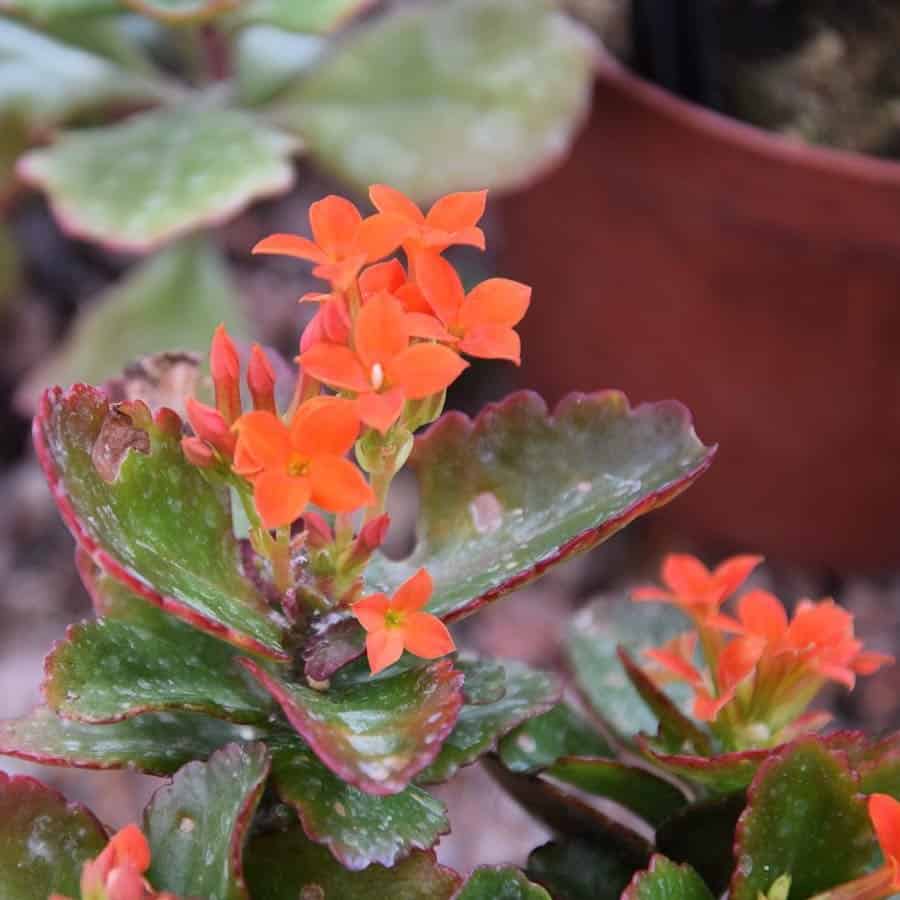
Kalanchoe crenata is a shrubby succulent with bright orange flowers. It has thick, glossy leaves densely arranged along its woody stems. The late autumn and winter months bring inflorescences with spherical heads of long, tubular orange flowers.
Kalanchoe fedtschenkoi
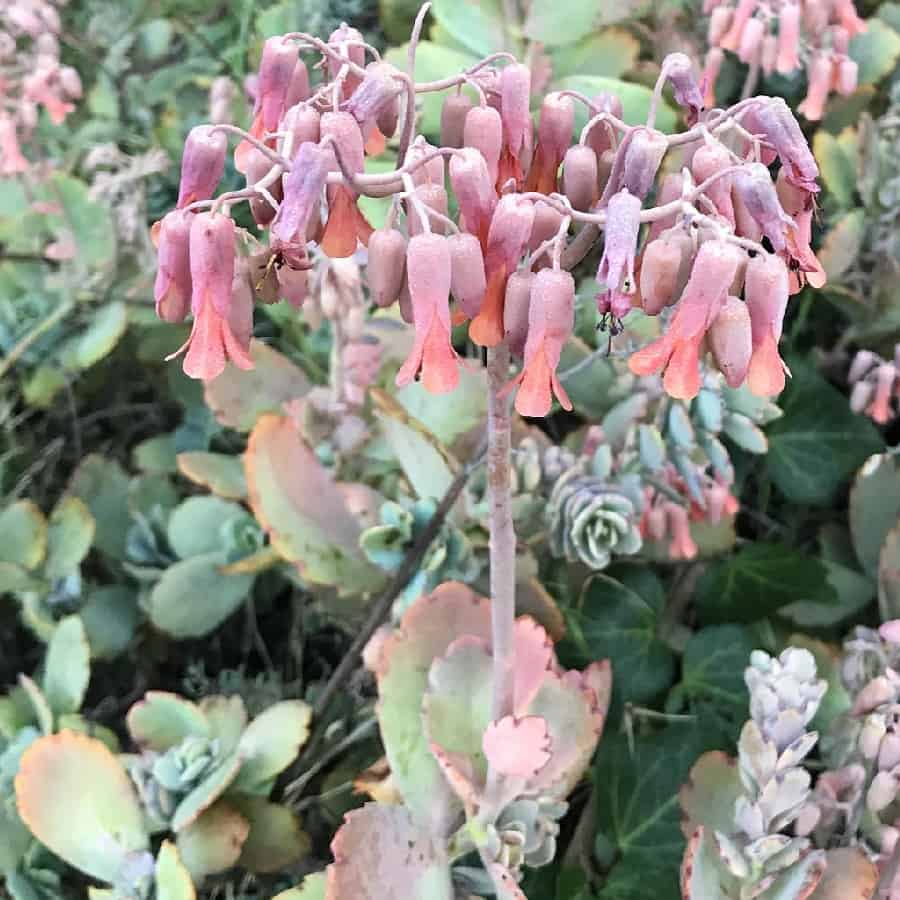
As Kalanchoe fedtschenkoi matures, this small succulent shrub expands and grows taller. It produces lovely purplish orange flowers. Its oval-shaped leaves have a soft, velvet-like texture and creamy white variegation along the edges. When under stress, the edges of the scalloped leaves turn pink.
Kalanchoe manginii
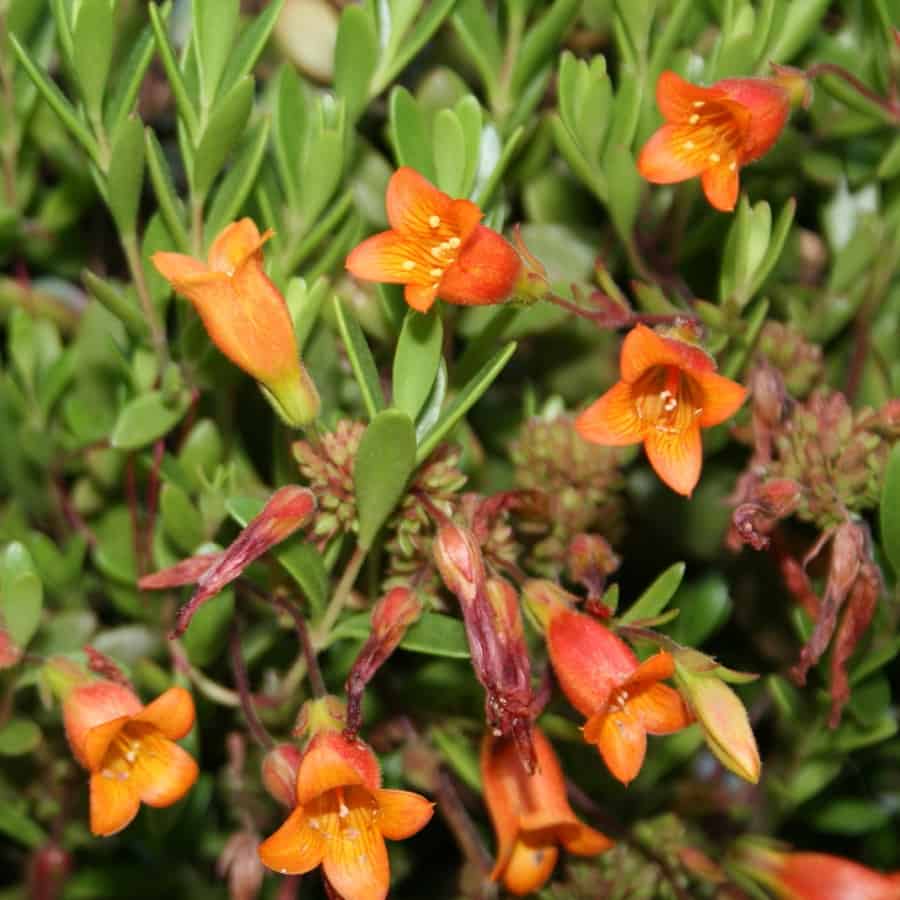
Kalanchoe manginii, also called Beach bells, is a flowering succulent indigenous to Madagascar. It is a deciduous perennial that reaches a height and width of 30 cm. In the spring, it bears urn-shaped salmon-red flowers on arching branches of glossy, rounded leaves.
Kalanchoe rotundifolia
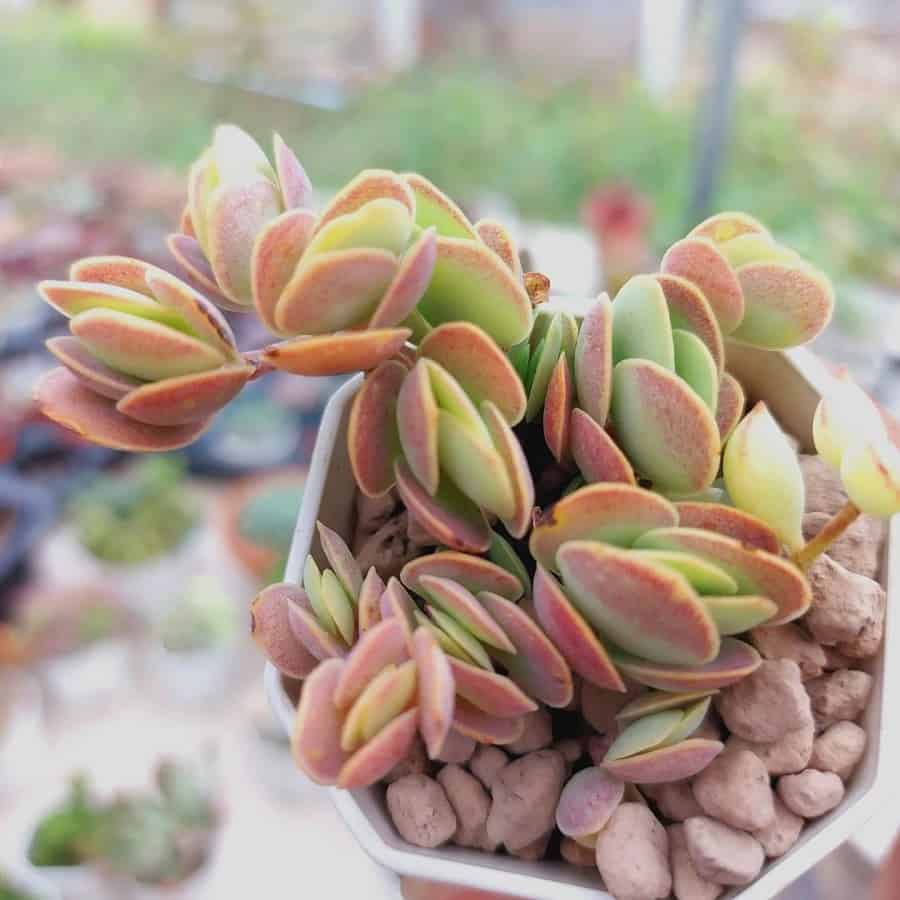

Under favorable conditions, the beautiful Kalanchoe rotundifolia can grow up to 1 m tall in clumps among shrubs and trees. Its inflorescence, represented by a tall, upright stalk, bears yellow or orange flowers. As these flowers age, they turn crimson and distinctly twisted. The blooming period of this plant occurs in autumn and the beginning of winter.
Kalanchoe х houghtonii
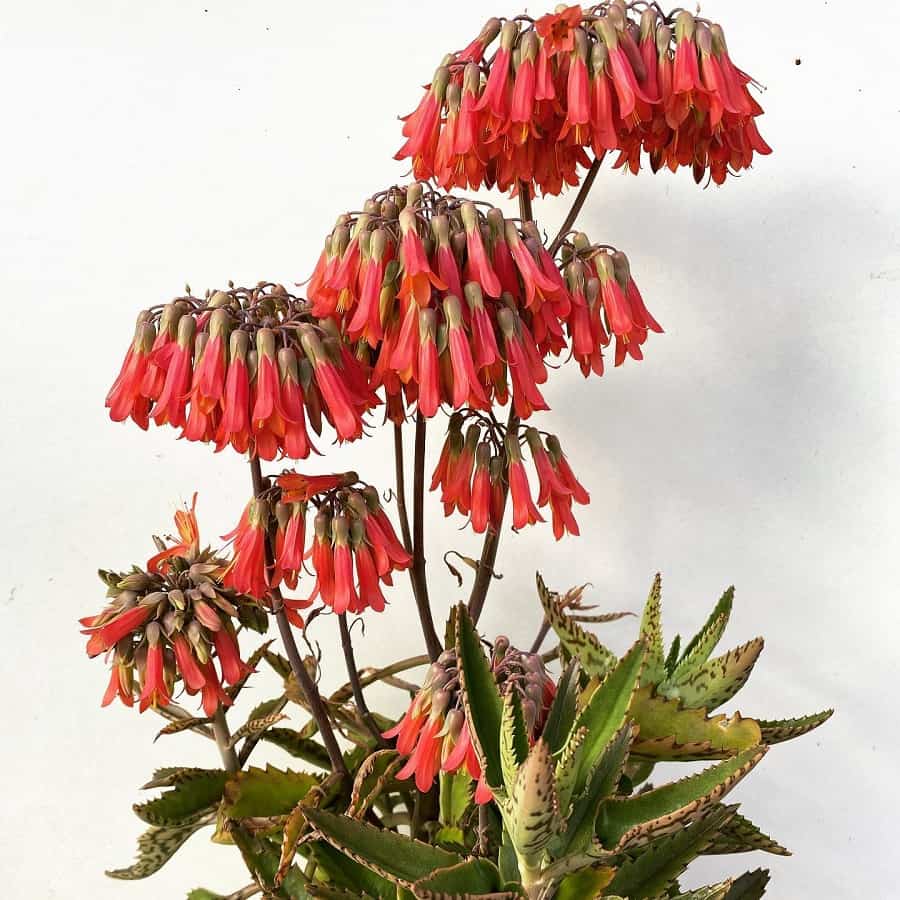
Kalanchoe x houghtonii, known as a Mother-of-Millions hybrid, stands out with its V-shaped leaves. It is an upright, unbranched biennial plant that grows to about 75 cm in height. The leaves are boat-shaped, fleshy, and colored brownish green to emerald green, often with purple spots on the underside and serrated edges. New plants are generated along the leaf margins. The plant showcases pendulous blossoms in shades of orange and pink.
Lampranthus aurantiacus
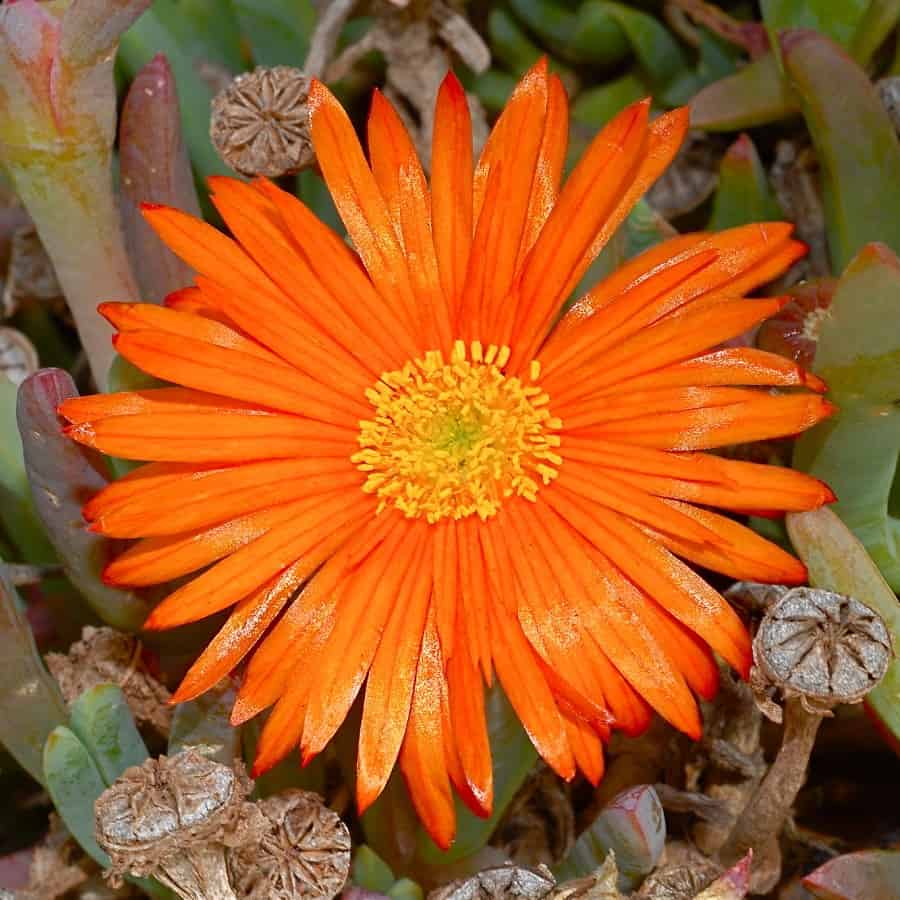
Lampranthus aurantiacus is a type of succulent known for its profuse blooming between June and August. Its flowers are incredibly vivid and colorful, ranging from reds, pinks, oranges, and purples. Sometimes, the flowers even display two colors. The leaves of this plant can be triangular or round in shape and have a smooth, elongated appearance.
Lobivia jajoiana
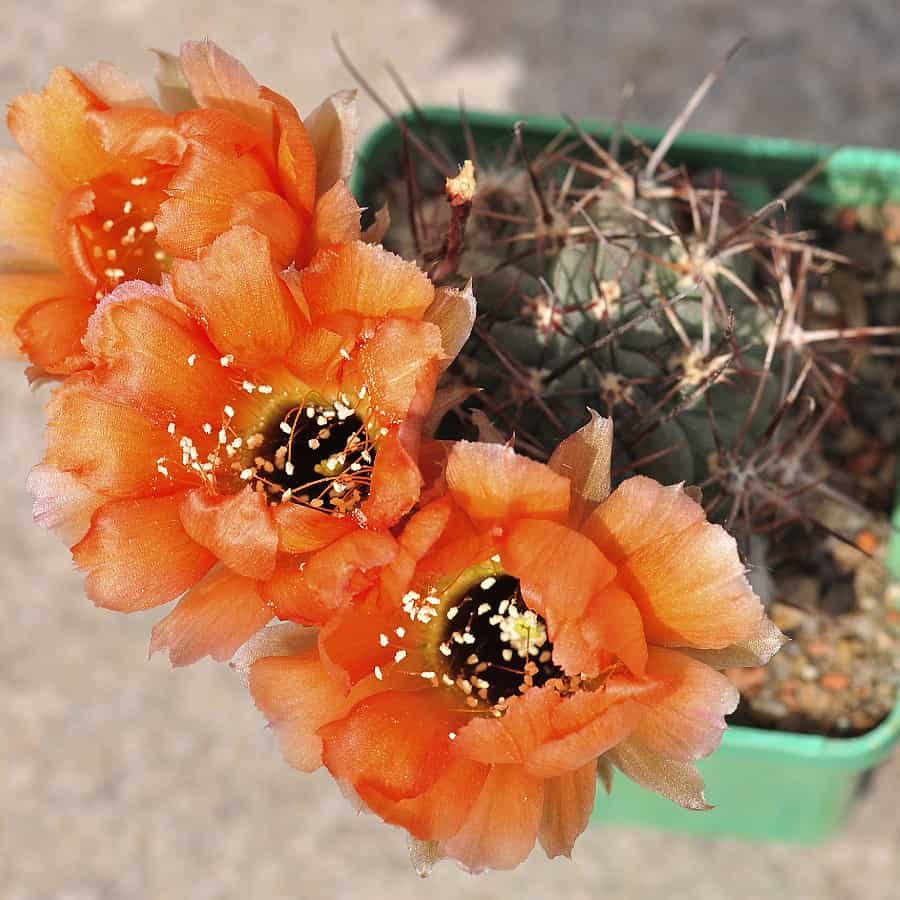
Lobivia jajoiana is a popular small cactus that delights with its multicolored blooms. These flowers come in shades of yellow, vine-red, orange, and violet. The throat rings of the flower, called hymens, are deep purple-violet to black, glossy, and thicker at the edges. This cactus can grow individually or in clusters.
Opuntia rufida
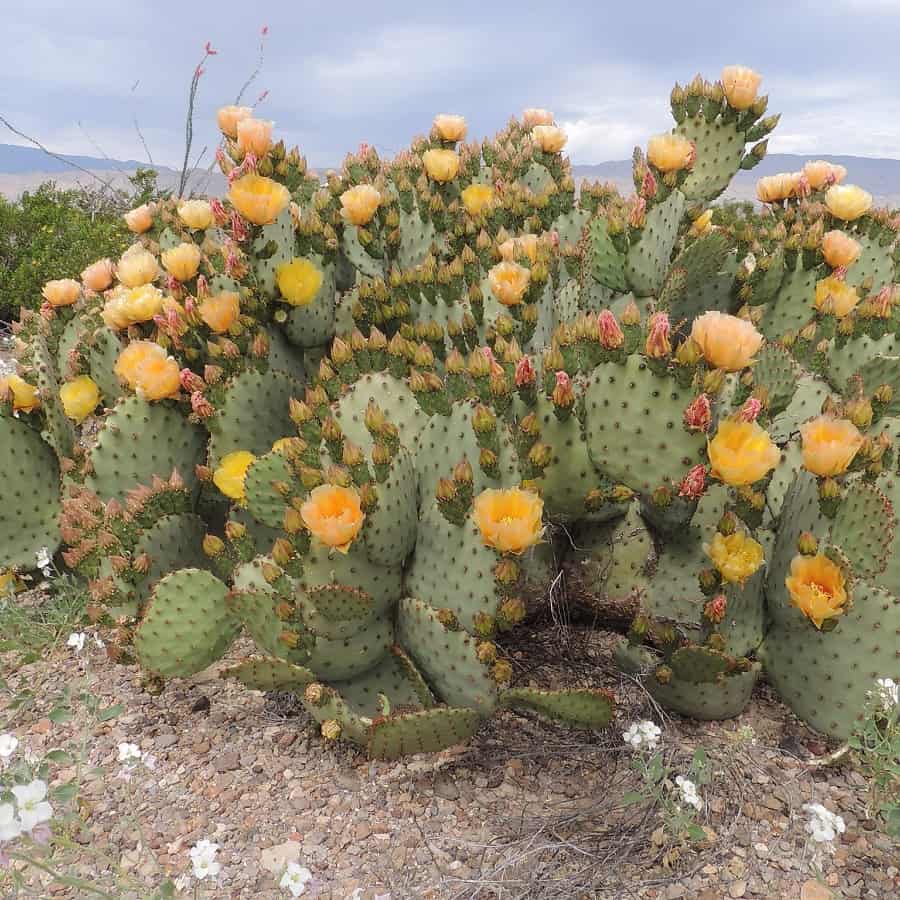
One of the prickly pear cacti that doesn’t have spines is called Opuntia rufida. It grows up to 6 feet tall and forms a big, upright clump. The clump is covered in thousands of grey or green pads that are about 6 inches long. These pads branch out from a low central stem. In late spring, the pads burst with lots of orange-yellow blooms. The spots where the spines would be are scarlet in color.
Pachyphytum oviferum
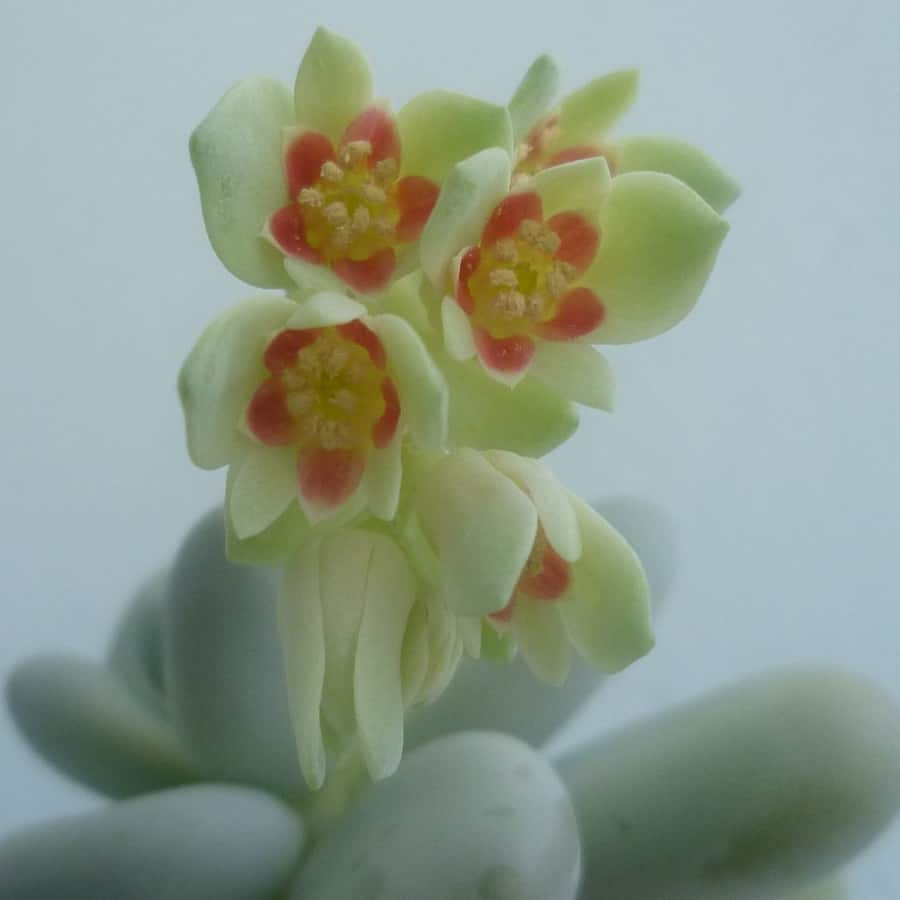
This succulent grows in clumps and has thick, rosette-shaped leaves. The leaves range in color from bluish-purple to mild blue-green at the ends of short stalks. The leaves are oval-shaped or elliptical. At first, the stems are upright, but they eventually become droopy. From winter to early spring, deep red-orange bell-shaped flowers appear in clusters on arching stalks that are about 30 cm long. The flowers have cream-colored petals with a small, circular, dark purple-red patch on the tip. They are surrounded by greenish-white sepals.
Rebutia fiebrigii
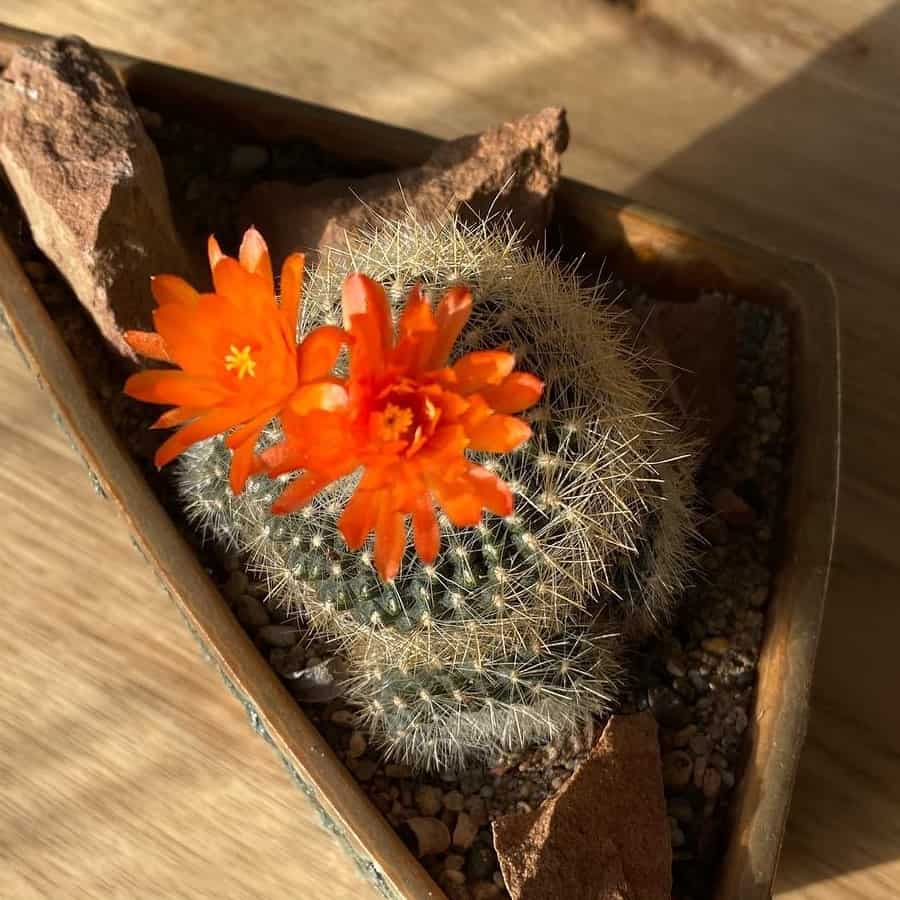
Rebutia fiebrigii is a small cactus that can either grow alone or form a mound. It reaches a height of 15 cm. Its body is covered in light green bumps and has short, silky spines that are white in color. This species of cactus blooms freely and has a lot of variety, with beautiful red flowers.
Rebutia muscula
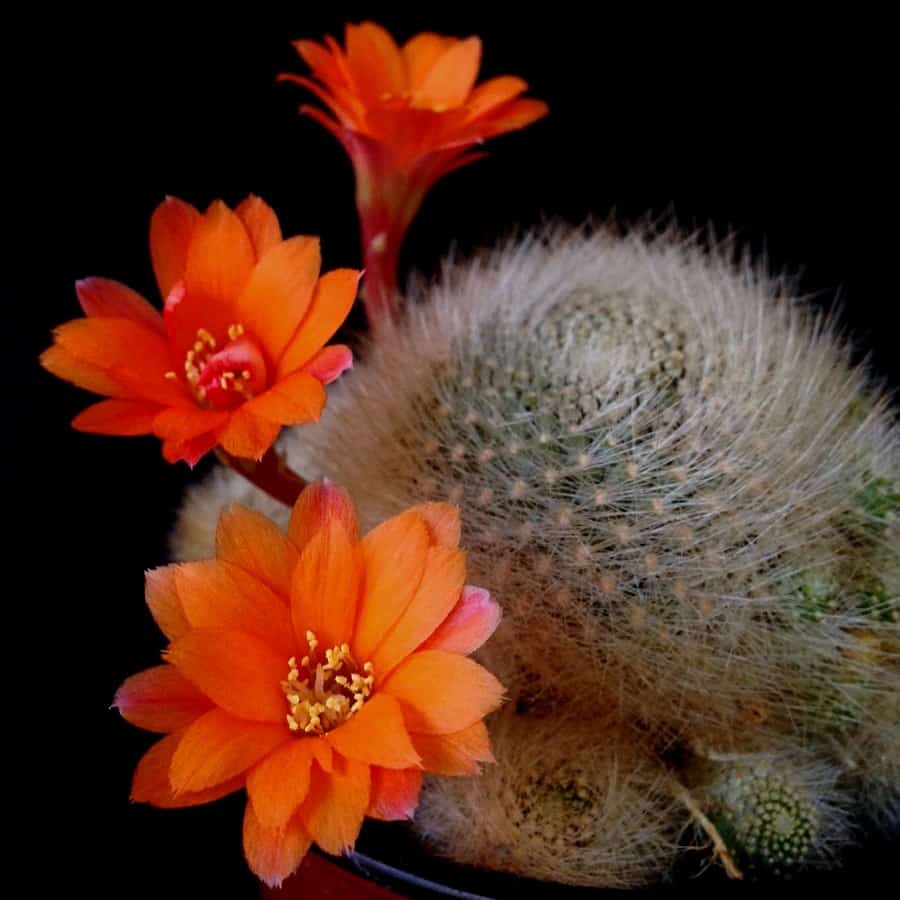
Rebutia muscula is one of the many variations of Rebutia fiebrigii. It blooms bright orange-red flowers and forms a low cushion covered in white, hairy spines.
Sedum kimnachii
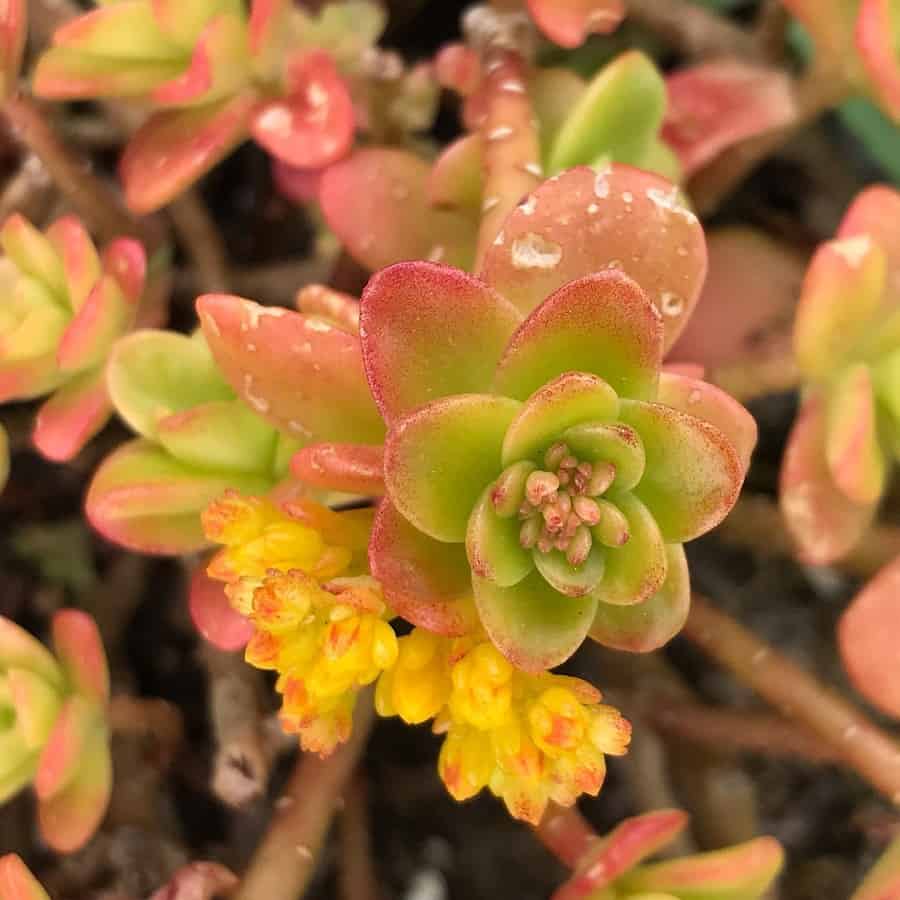
When grown in good soil and given water, Sedum kimnachii is an excellent succulent species. It creates a dense, flat carpet of shiny, rounded, yellow-green leaves. In a less favorable environment, especially during winter, the foliage develops beautiful orange colors. Every year in spring to early summer, clusters of fragrant, golden-yellow-orange flowers appear.
Sedum palmeri

Sedum palmeri is a spreading evergreen succulent with multiple branching stems. It forms rosettes of spoon-shaped, fleshy, gray-green leaves with sharp tips. When it’s cold or exposed to bright light, the leaves turn reddish-pink. In spring, small stalks with clusters of yellowish-orange flowers appear.
Tylecodon paniculatus
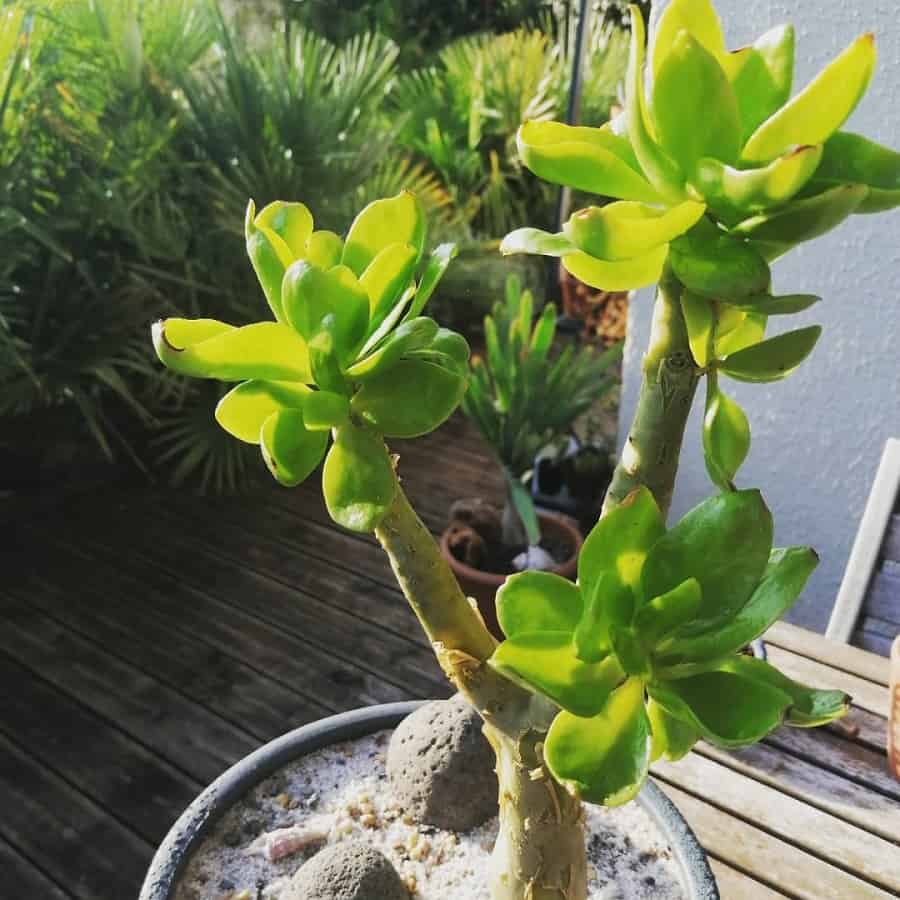

Known locally as the “Butter Tree,” Tylecodon paniculatus is a perennial succulent shrub. It has drooping, urn-shaped blooms that are 15-20 mm long. The blooms grow on branched stems opposite to the tips of bright green, paddle-shaped leaves. These leaves are absent during flowering. The flowers can be greenish orange, vivid orange, dark red, or purple-red.
Tylecodon rubrovenosus
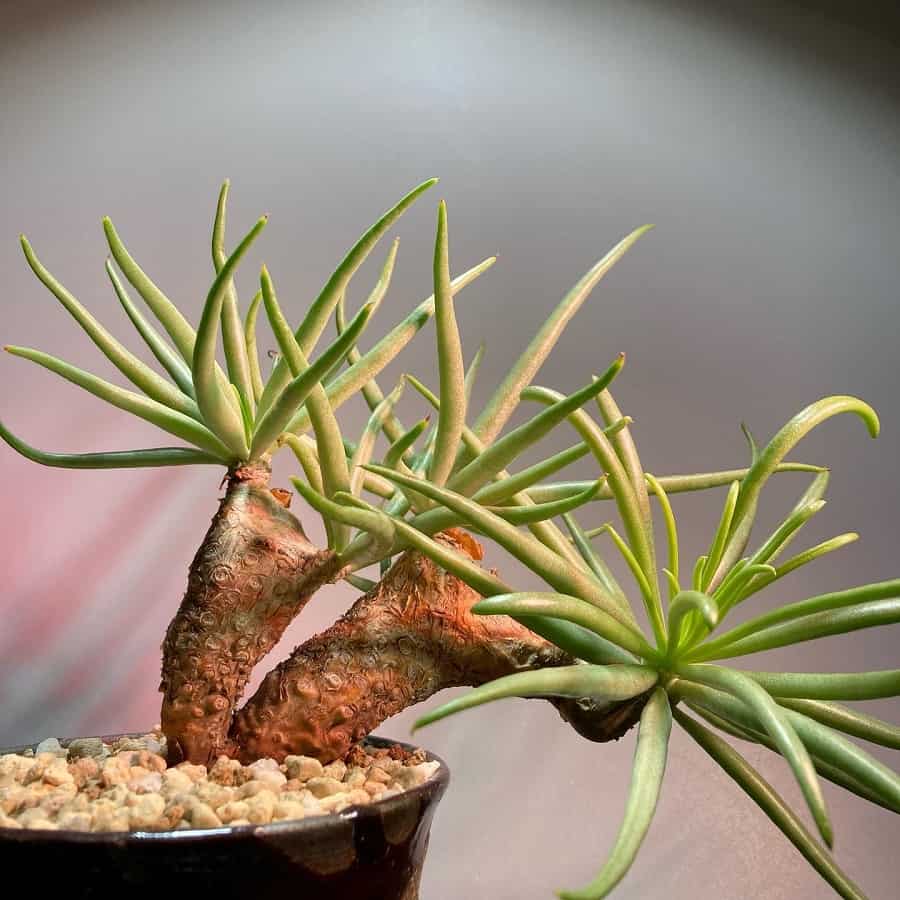
Tylecodon rubrovenosus is a sparsely branched perennial succulent shrub that reaches a height of 30-35 cm. It has a single main stem with short, thick branches covered in leaf scars. The flowers are yellowish-orange and hang down. They are also glandular and hairy.
Conclusion
Cacti and succulents come in many different shapes, sizes, colors, and types. From the famous saguaro cactus to the rare Lobivia jajoiana, these tough plants are incredibly beautiful and bring life and color to any garden. With such a wide range of species available, you can choose the best cactus or succulent that suits your needs. Whether you prefer tall and sturdy cacti or low-growing succulents for decoration, these hardy plants with orange flowers are a fantastic addition to any home.
